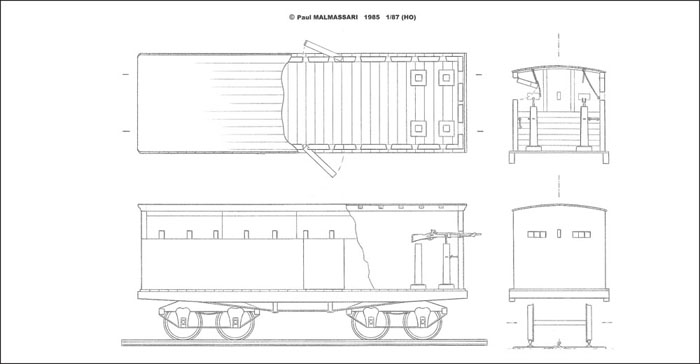
Inspired by the British plans for a railway to run the 28 miles (45km) from Stockton to Darlington, in 1825 Capitaine de Frégate (Commander) Montgéry launched the idea of ‘a type of steam-powered defensive war wagon, or mobile casemates, which if employed on a large scale would be formidable fortifications, and would be capable of manoeuvring on railway lines more rapidly than the finest cavalry units. This machine would comprise three vehicles proof against cannon shot. One of these vehicles, placed centrally, would be equipped with a steam engine. Each of the two others would carry three howitzers … The all-up weight of a casemate thus equipped, with its small garrison, and the appropriate munitions, would be approximately 85,000 kg [almost 94 tons]… .’ The inventor envisaged their deployment ‘especially for the defence of defiles, of highways, of main roads in non-fortified strategic towns, the approaches to certain fortresses, and chosen beaches … ’. Unfortunately, it appears that no plan of this armoured train has survived.
In November 1866 during the Mexican Campaign plans were drawn up for a defensive wagon to counter the attacks of irregulars, which caused severe problems right up until the evacuation of the French Expeditionary Corps. The bogie wagon, protected by wooden cladding 12cm thick, was to have had eleven firing embrasures per side and three at each end. From the support pillars shown in the drawings it is possible the armament would have included large-calibre rampart guns, as befitting a ‘mobile fortress’.
In 1841, M. Schwickardi proposed a ‘cannon-wagon’, proposed for the defence of fortresses, and also for the defence of Paris. The mixed road-rail ‘armoured machine’ of Zéphyr Toffin dates from March 1858: 4m (13ft 1½in) long by 2m (6ft 6¾in) wide, armoured including cones protecting the wheels, and to be armed with three Mitrailleuses. The design was presented by the inventor again in December 1870. In 1862 Captain Veillet proposed armoured ‘wagon-batteries’ 3.1m (10ft 2in) long by 2.1m (6ft 10½in) wide by 1.9m (6ft 3in) high, to be formed into convoys.1

The plan of the armoured wagon proposed for the campaign in Mexico. It is not known whether it was actually constructed.
(Plan by the Author based on the original in SHD Archives)
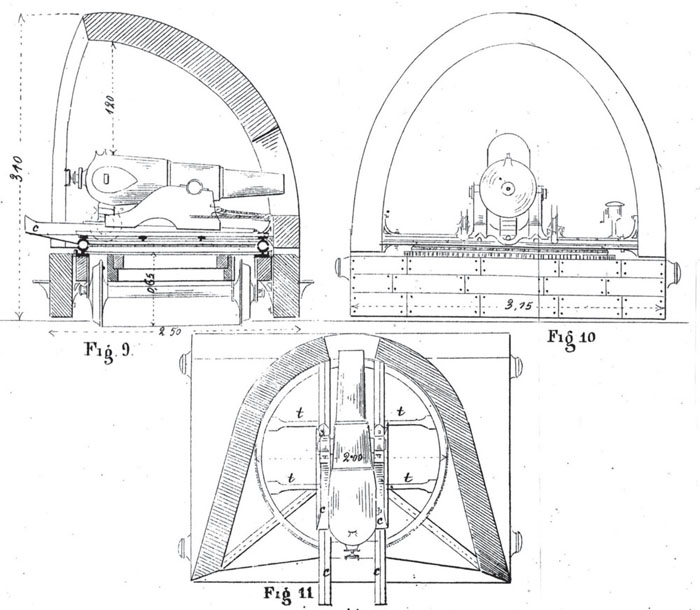
Layout of the armoured wagon (35cm of wood covered by 18cm of metal) proposed by Michel Body
(Plan: Les Chemins de Fer dans leurs applications militaries, Plate IV)
On 10 November 1863, the Artillery Committee received from Thomas Wright, a British subject, his project for a battery on rails which ‘apart from being suitable for the French coasts, is also proposed for Algeria, India and the French “colonies”’. These trains composed of three or four batteries, each armed with between ten and forty guns and mortars on pivoting mountings, would have formed a defensive barrier extending over a mile (1.5km).2 Then in 1868, Michel Body presented his ideas of an integrated defensive system, encompassing railway systems, fortresses and armoured railway stations. He specified the construction of ‘cannons mounted on trains and special motors proof against enemy fire [providing] this artillery with incomparable mobility’,3 as detailed in the plan above.
The origins of this train go back to 1867, when Colonel Brent, an American, had outlined to Napoleon III his ideas for railway war machines. Marshal Niel and General Leboeuf had considered the project, and had confided it to Captain de Reffye, Director of the Meudon Workshop, to be built in the utmost secrecy. The Armistice went into effect before the train could be used against the Germans. It was seized by the Paris Commune on 9 February 1871 and used on the Chemin de Fer de Ceinture (the peripheral railway line around the city centre). After the war, it was planned to keep the train for deployment at Douai, but weight and loading-gauge problems led to it being broken up by the Chemin de fer du Nord on 20 June 1872.
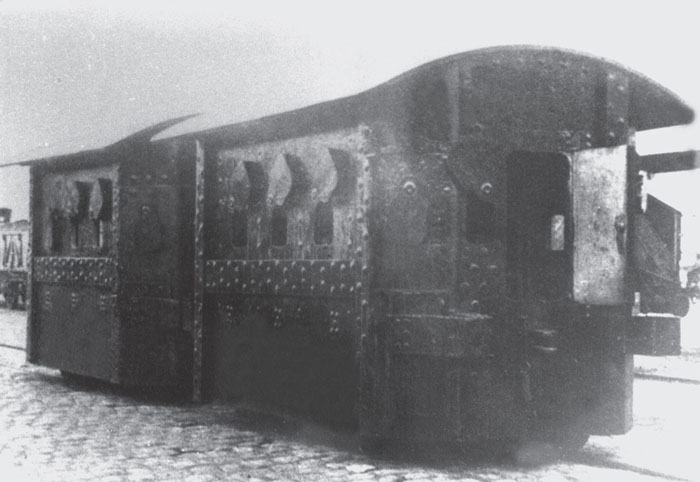
Two wagons of the Meudon Armoured Train. 13mm Mitrailleuses would have fired through the protected scuttles. The whole train weighed 85 tonnes.
(Photo: Musée Carnavalet)
Out of all the numerous projects and inventions presented to the authorities, the one by Messrs Solacroup and Delannoy, two engineers of the Chemin de fer d’Orléans, caught the attention of the Paris Defence Committee. Their first design study consisted of one or two large-calibre guns mounted on a platform carried by two trucks placed side-by-side on the double track and pulled by horses. The second design study had a single platform carried on two parallel tracks, armoured on three sides with lengths of rail. Finally, their third design was a wagon fully armoured with rail lengths, roofed over by a curved plate. The front face was pierced by an embrasure allowing fire up to 30 degrees on either side of the central axis.
The Committee decided to build the fourth version proposed, being two four-axle wagons, armed with a 14cm gun firing en barbette over the top of the armour, 30 degrees to either side of the central axis, immediately followed by two other wagons, each armed with a 16cm gun mounted in a pivoting casemate. The firing embrasure in the 16cm battery had been much reduced in size compared with the previous proposals, and the roof was armoured.
In action two gun wagons were to be disposed side-by-side on parallel tracks. Behind the gun wagon on the track on the side facing the enemy was a second gun wagon. In place of the proposed armoured engines, two tank engines could be used to move the batteries. A tank engine would run on the track facing away from the enemy, propelling a leading gun wagon. On the side facing the enemy the engine would be protected by the second gun wagon in line, which was connected to the engine by a system of chains. After use for the defence of Paris, then by the Commune, these trains were broken up in 1871.
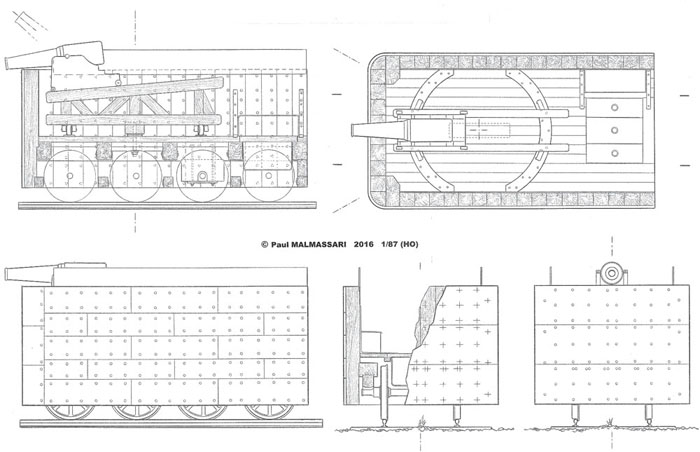
The drawing of the 14cm en barbette wagon. The gun had a maximum range of 3300m (3600 yards) and required a crew of eleven men. The allup weight was 40 tonnes.
(Plan: Paul Malmassari)
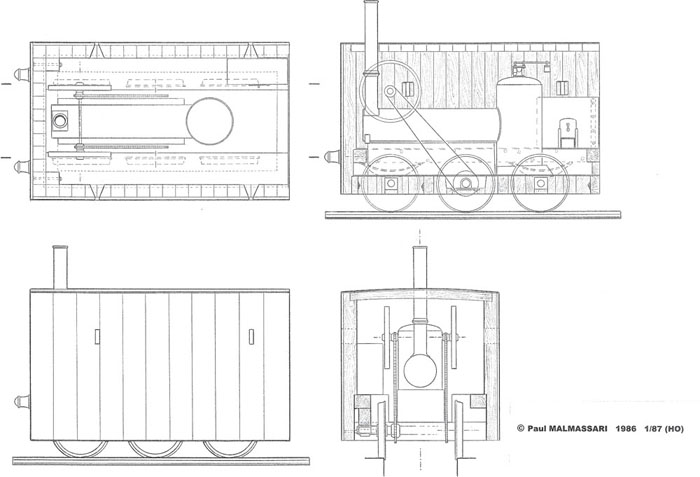
Drawing of the engine which was protected by 5cm of iron over a wooden framework. It weighed 35 tonnes, or considerably less than the wagons it was supposed to move. The curious chain drive (from vertical cylinders? – not shown) to the centre axle is perhaps necessitated by the fact that the engine is a well-tank, with its water supply positioned below the boiler where one would normally expect to find the cylinders and cranks.
(Plan: Paul Malmassari)
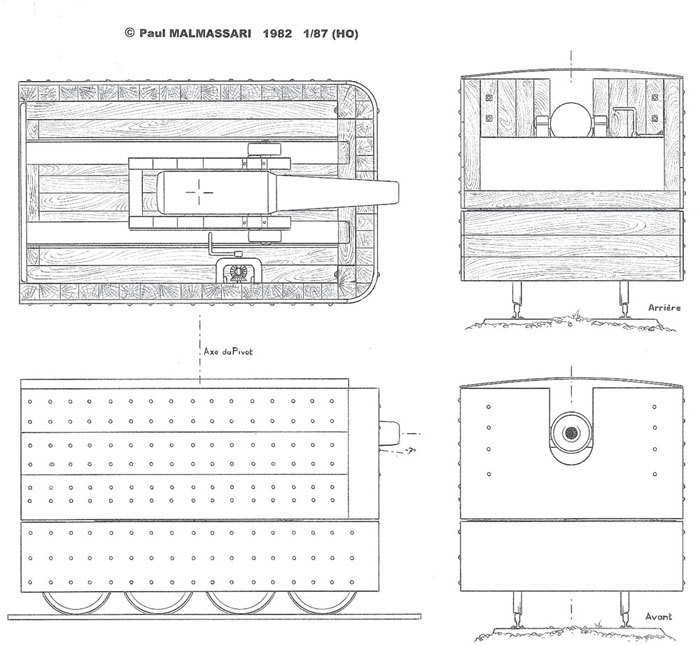
Drawing of the pivoting casemate battery armed with a 16cm gun, with a range of 3900m (4265 yards) served by a crew of 13 men. Total weight was 47 tonnes.
(Plan: Paul Malmassari)
An armoured train was ordered from the Compagnie du Midi at the end of 1870. At the time of writing, research had turned up no details of this train, which was constructed at Bordeaux. Again in 1870, the Compagnie de l’Est constructed armoured units. The main action undertaken by the Est armoured train was the capture of a goods train at Peltre, near Metz, on 27 September 1870. To the west, General Kératry, commanding the Army of Brittany, ordered the Compagnie de l’Ouest at Le Mans to construct three armoured trains, each comprising eight vehicles.
At Périgueux, beginning in early September 1870, the Compagnie d’Orléans had also built twenty-four wagons, identical to the Parisian models with pivoting casemates, which were intended to be used against the Prussians. But Paris capitulated before the train could intervene. Then on the morning of 11 April 1871, the Versailles Government ordered the train to make its way towards Paris to take part in the battle against the Commune. At the end of the morning, on hearing of this, the staff of the railway workshops deliberately overturned wagons on the tracks, delaying the departure of the train until 12 April, after which date it disappears from history.
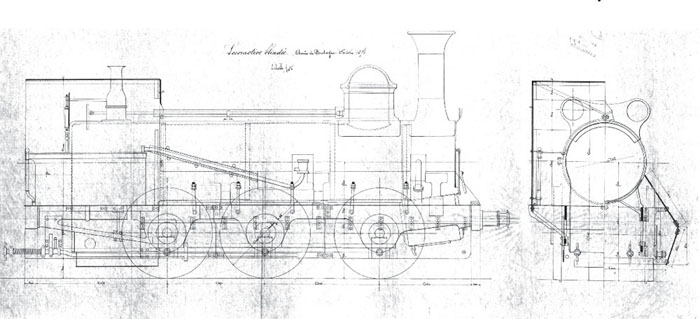
The original drawing for the engines of the Army of Brittany.
(Plan: SHD)
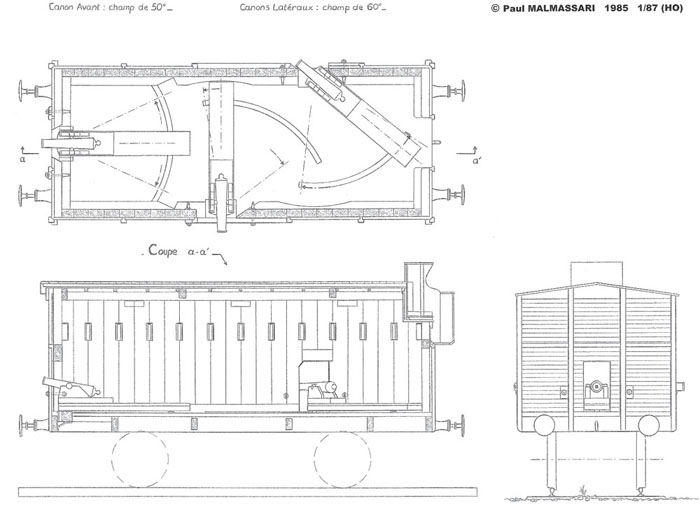
Drawing of the wagons of the armoured trains of the Army of Brittany.
(By the Author)
Based on the lessons of the War of 1870–1, the future role of armoured trains would not be limited to defence alone, but would also encompass active employment designed to help push back the front lines. Numerous propositions dealing with this have come to light, like the project shown in the illustration below: the two rails of the central track are used by replenishment trains carrying munitions and coal. The gun battery and its engine run on the two outside rails. They make use of the firing embrasures let into the parapet at intervals, and the gun also uses a disappearing mounting. The artist appears to have imagined the small munitions locomotive – a Crampton – being fitted with a folding chimney, enabling it to take cover inside a tunnel in the body of the gun battery.
This Commission had been created on 11 June 1878, presided over by General Schnéegans. After having collated the existing documentation relating to the railway batteries during the Siege of Paris, the Committee decided to proceed with the construction of separate prototypes of wagon and engine, in order to evaluate the form and resistance of the armour protection, and the type of armament and the maximum traction effort to be adopted. Firing trials against the engine took place on 15 May 1879 in the sand quarry at Courbevoie, and led to armour protection designed by M. Mayer, Chief Engineer, Rolling Stock and Traction, of the Compagnie de l’Ouest. The wagons from the Est rail network were armoured with plates 10mm thick weighing a total of 4.5 tonnes. After three years of study, the decision was taken to create two types of train: reconnaissance trains (at first known as ‘combat trains’), and trains intended for sorties from fortresses – but the latter type was quickly abandoned. The first train (which would remain the sole example), was assigned to Belfort in 1887.
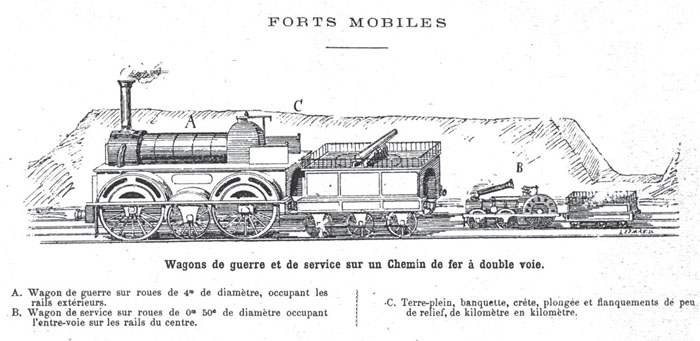
An illustration from Un bourgeois de Paris, Système de défense de Paris basé sur l’emploi des chemins de fer, des locomotives et des wagons blindés
(Saint-Nicolas-de-Port: E Lacroix, 1871).
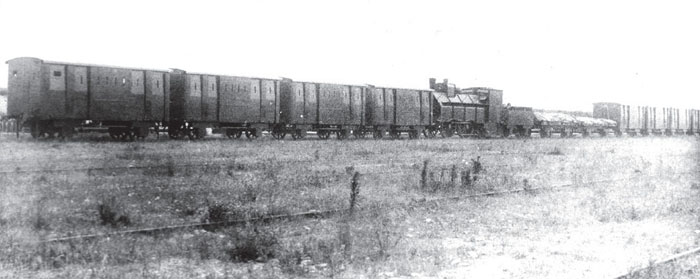
The experimental armoured train assigned to Belfort, seen here during manœuvres. The engine and flat cars were placed in the centre of four wagons to front and rear. The main defect was the deafening noise caused by the armour plates, which were hung on the wagon sides but not fixed firmly in place.
(Photo: La Vie du Rail)
At the request of General Brialmont, in 18856 Commandant Mougin had conceived an armoured battery on rails, an immense device weighing 330 tonnes! It was described as follows: ‘this project may be considered as a hollow girder construction, armoured on four of its sides, and capable of resisting substantial external shocks without deforming. This girder structure is fixed to a strong platform carried on nine sprung axles, allowing the whole battery to change positions. Two end panels and two internal frames separate the battery into three compartments, each enclosing a cannon. The armour on the side facing the enemy consists of two thicknesses of 45mm laminated iron plates …’. It was intended to deploy these batteries principally on the parapet of a continuous defensive line, and between two neighbouring forts, to cover the intervals in the case of an attack on the forts.
The armament was to have comprised three 155mm guns, each able to traverse through an arc of 70 degrees, with elevation from –5 degrees to +20 degrees. The maximum range was 7000m (7655 yards). The track gauge was to have been 3.15m (10ft 4in) at a time when the standard rail gauge in France (prior to standardisation) varied between 1.44m (4ft 8½in) and 1.5m (4ft 11in). Overall each battery would have measured 12.45m long x 3.5m wide (40ft 10in x 11ft 5¾in).
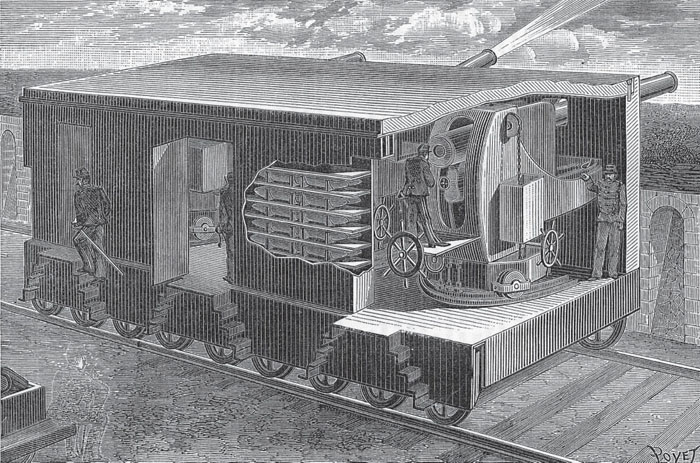
Armoured battery proposed by Commandant Mougin.
(Illustration: La Nature No 703 [20 November 1886], p 389)
Designed to run on rails and on roads, Gregori’s ‘armoured mobile battery’ was intended to replace permanent and coastal fortifications, in Metropolitan France and also for defending the Colonies. The symmetrical layout was intended to protect the centrally-positioned engine, while the trucks at each end were used for observation and armament. In addition, the oval form of the vehicle’s sides was supposed to offer superior protection compared with the usual vertical side walls. The secondary armament appears to be Hotchkiss revolver cannons, although Gatlings are also a possibility (they were being manufactured in France at that time for use in fortresses).
In the same year, this inventor proposed a ‘land torpedo’, inspired by naval torpedoes, propelled by a motor preferably powered by compressed air, and protected from rifle fire by a metal casing. The armament consisted of four ‘warheads’, which from the patent illustration appear to be large-calibre artillery shells with nose-mounted impact fuzes, covering four planes and intended to inflict all-round damage: to track, stations, platforms, enemy trains etc. The first shell exploding when its nose fuze struck a target – most likely the front one but one of the others could be activated if the enemy derailed the device – would then set off the remaining shells.
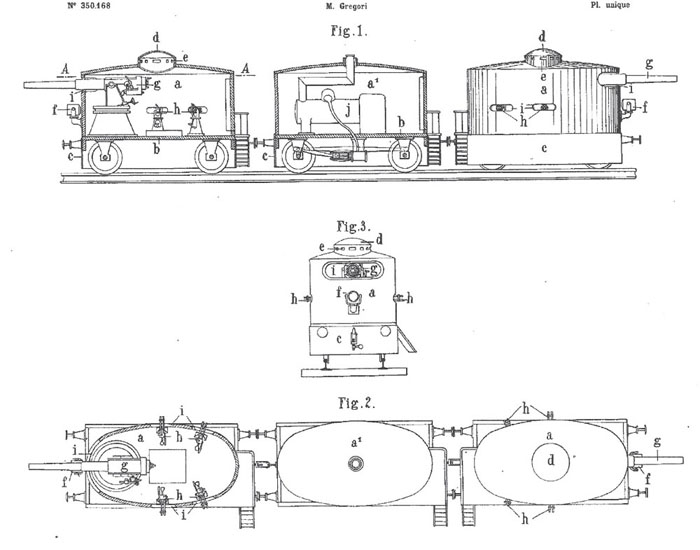
Detail from Patent No 350.168 submitted on 24 May 1904, granted on 13 September 1905.
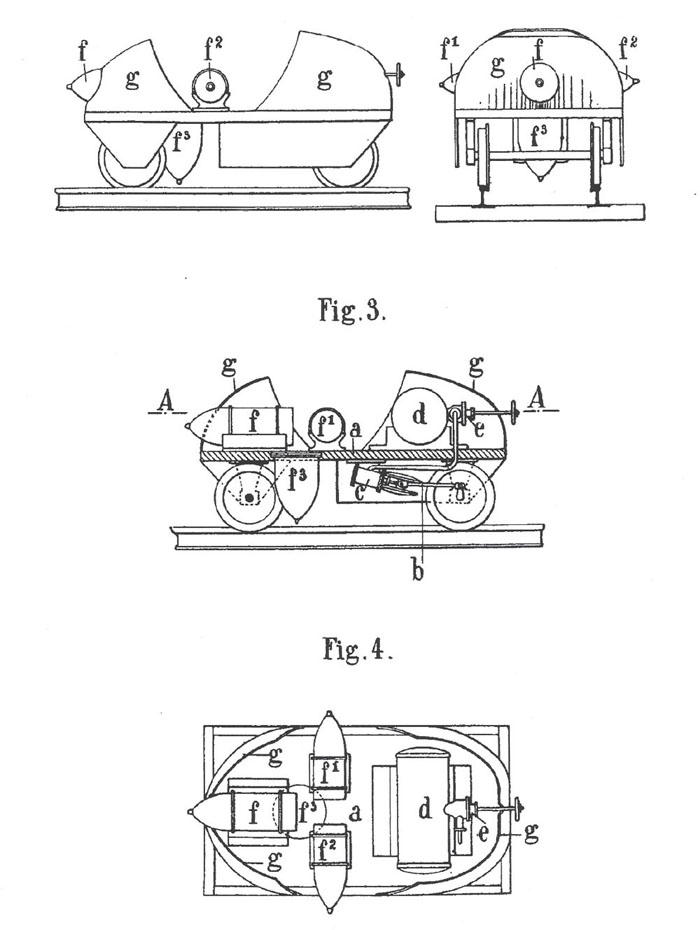
Detail from Patent No 350.169, submitted on 28 May 1904, granted on 13 September 1904.
The river system and the railway network were the two methods of transport in this colony. During the uprising, the rebels began attacks on the railway in January 1910. An armoured train service was put into service which helped suppress the revolt.
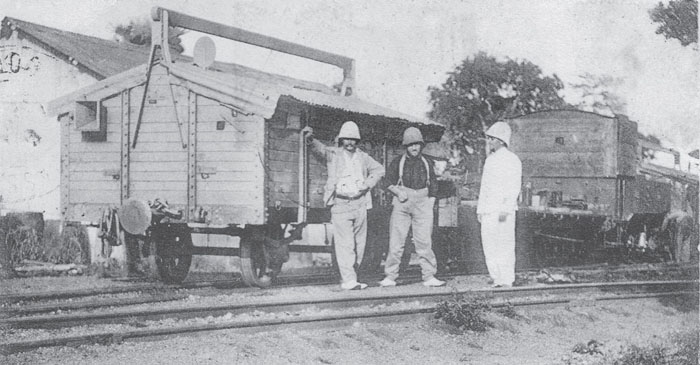
Basic protection but sufficient against the arms used by the tribes in the Côte d’Ivoire: note the timber cladding on the engine.
(Postcard: Paul Malmassari Collection)
The conquest of the German colonies in Africa involved the use of armoured trains of which no photos have so far come to light. While the Germans used armoured trains in Togo and Cameroon, the French deployed them only in Cameroon.
A naval gun was mounted on a wagon, probably armoured, for the advance on Medéa. Several wagons were fitted with armour protection for train escort duties and to fend off German harassing attacks, during which tracks and bridges were blown up. An armoured lorry was also built between 12 and 30 September 1915 and was used on the So-Dibanga–Eseka line.8
Ordered on the declaration of war and designed very rapidly by Engineer General Gosselin in September 1914, with the initial aim of bolstering the ring of defences around Paris, three 95mm-armed armoured trains were built by the Batignolles Company using armour plates from the Commission in Gâvres. Each of the three trains comprised four wagons armed with a 95mm Model 1888 gun, plus corresponding ammunition wagons. A fourth train was assembled with two longer wagons each armed with two 95mm guns. They were delivered between the end of 1914 and the beginning of 1915, and remained in service until March 1916.
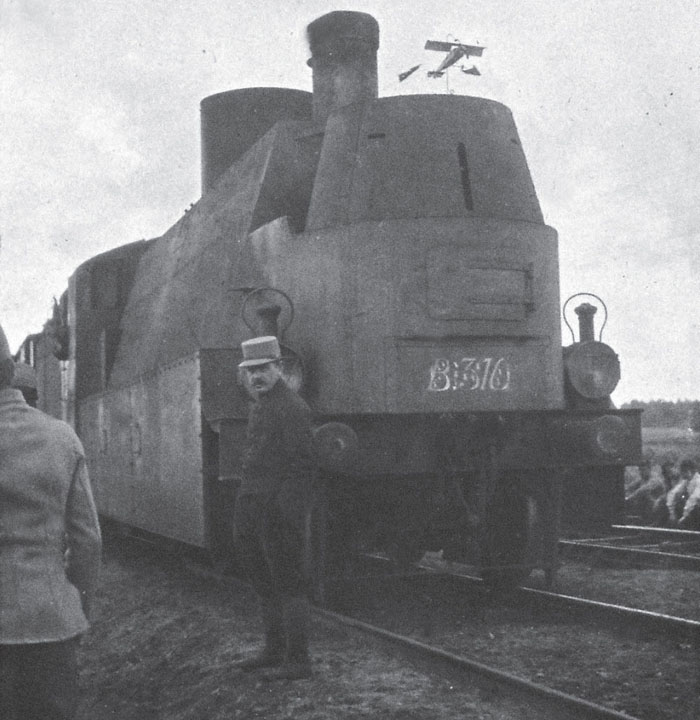
The lack of armour protection to the lower front end of this PLM engine shows that these trains were not intended for offensive operations. Of note is the miniature aircraft model mounted like a weather vane, but which we believe may be a visual indicator to the engine crew of the direction the turret is facing.
(Photo: Paul Malmassari Collection)
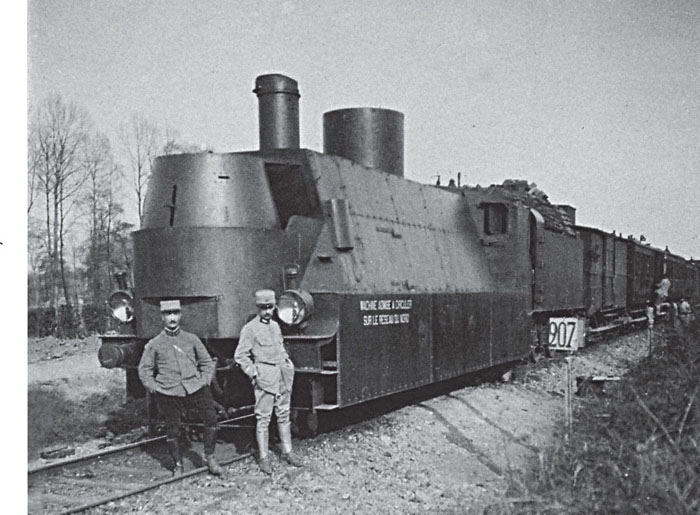
One of three armoured PLM Type B 111-400 4-4-0 engines requisitioned between 15 and 27 November 1914. The armour protection was designed by the Batignolles Company but installed by the PLM workshops. The front turret armed with a machine gun is a rare feature in the history of armoured trains, and must have made cleaning ash out of the smokebox a difficult task.
(Photo: Paul Malmassari Collection)
The following plans by the Batignolles Company show the 95mm armoured train. This is the first time these technical drawings, held by the SHD Archives, have been published.
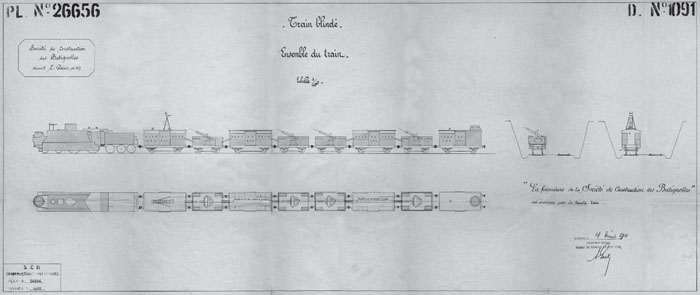
General arrangement drawing showing a complete 95mm armoured train. The leading van has an extending observation ladder, and the tail van is armed with a Hotchkiss machine gun in a turret.
(Plan: SHD Archives)
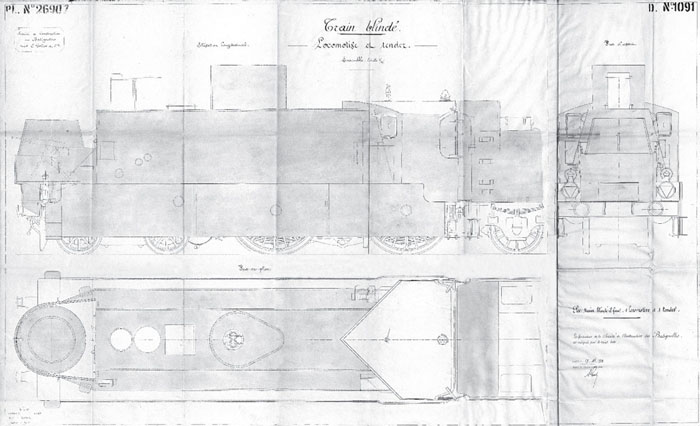
The PLM Type B111 4-4-0 A engine.
(Plan: SHD Archives)
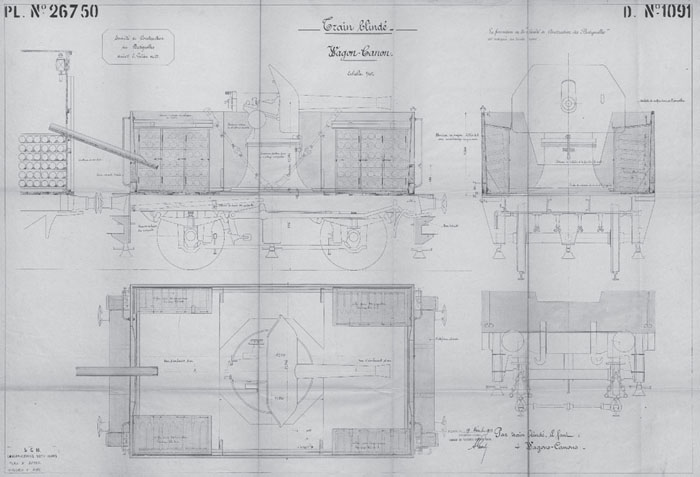
One of the 95mm gun wagons, with fixed side panels. Note the three jacks on each side for lifting the wagon wheels clear of the rails to relieve the stress on the springs when firing, and the clamps and spreader bars to fasten the wagon to the rails. Also the delivery chute from the ammunition van.
(Plan: SHD Archives)
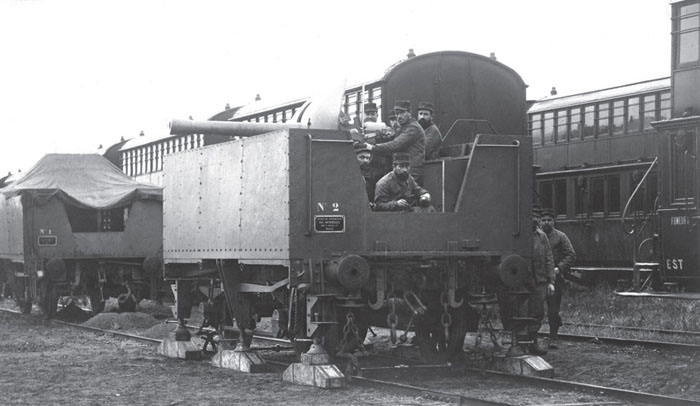
It took only two minutes to prepare each wagon for firing, by jacking it up on stabilisers, and by clamping it securely to the rails. The 95mm cannon had a maximum rate of fire of eight rounds per minute. Each gun wagon carried 104 complete rounds. Note the number of the individual wagon painted above the builder’s plate.
(Photo: SHD)
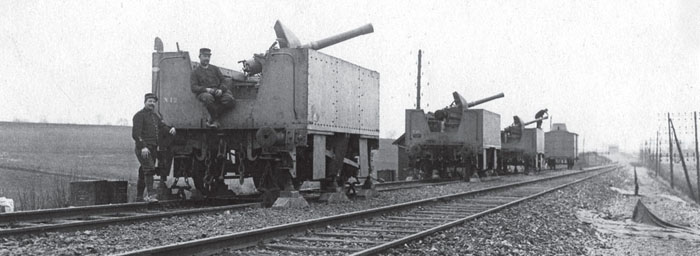
Batignolles built the armoured wagons in November 1914 on Nord 20-tonne flat wagon chassis.
(Photo: Guy François)
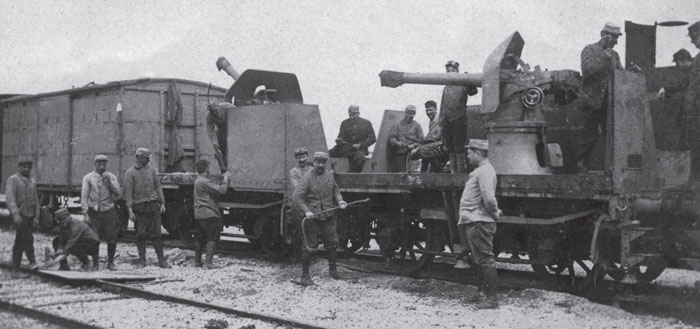
The armour protection of these wagons consisted of two 5mm steel plates spaced 5cm apart, with the gap filled with ballast gravel. Here the plates are partially dismantled, showing internal details.
(Photo: Guy François)
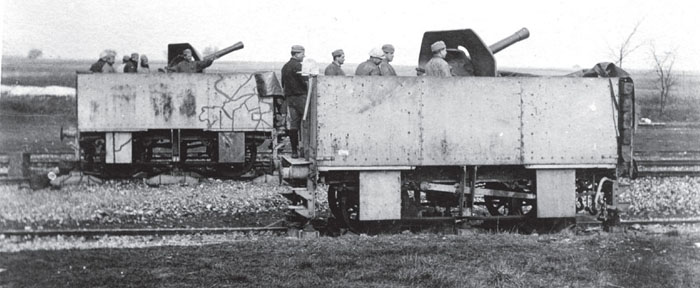
Wagons from a train with the Tenth Army in Artois. Each train had a crew of around forty men, including three officers. The armoured shields were fitted to the guns as early as 1893.
(Photo: Guy François)

An overall view of a train, compared with the plan. Note there are two tail vans with turrets, and in particular the exposed position of the artillery observers. Each ammunition van carried 1120 rounds.
(Photo: SHD)
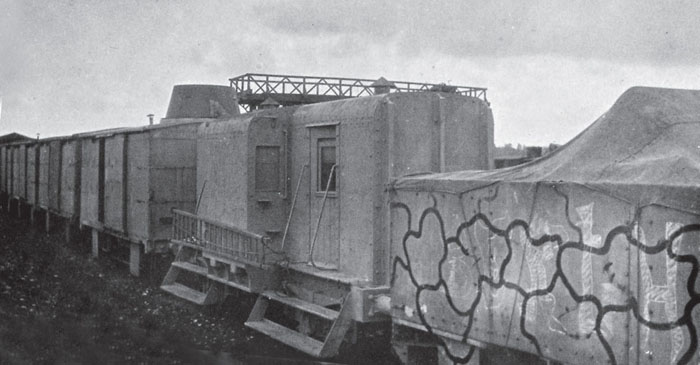
On the right is a camouflaged gun wagon, and central a Bika van transferred from a Belgian armoured train. Next in line is a tail van followed by four ammunition vans specific to the 95mm armoured trains.
(Photo: Private Collection)
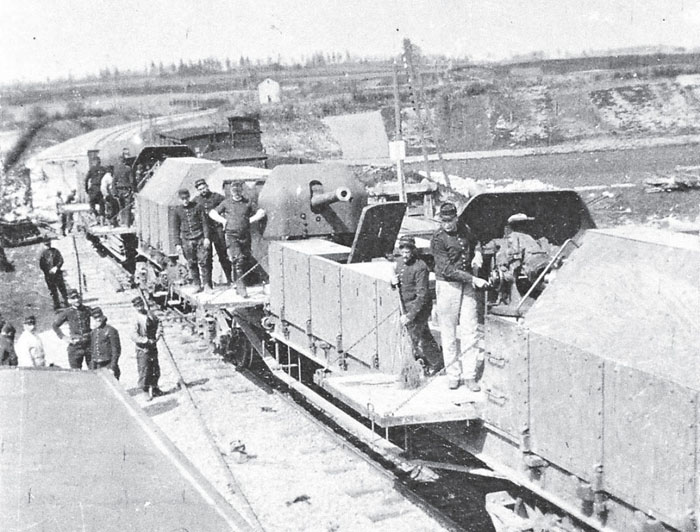
Armoured Train No 4 was built in Dunkirk, and entered service in February 1915. It was composed of two bogie wagons each armed with a pair of 95mm guns.
(Photo: Private collection)
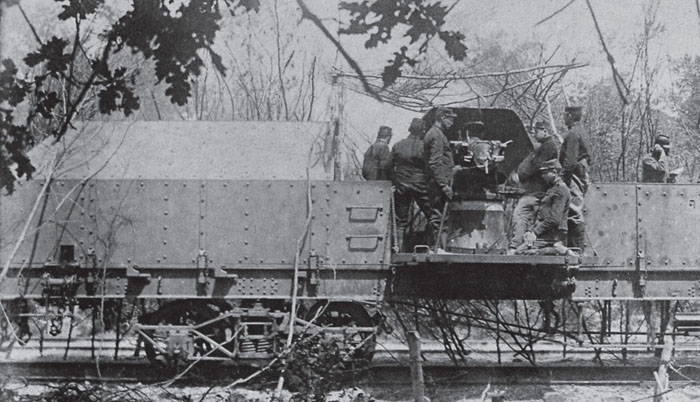
The gun crew were from the 39th Battery of the 1er RAP (1st Fortress Artillery Regiment), and the engine crew were from the 5ème Génie (5th Engineering Regiment). Armoured Train No 4 was sent to the Third Army, where it carried out many fire missions, notably against a long-range 15cm K.i.S.L. gun, and was itself hit twice.
(Photo: Private collection)
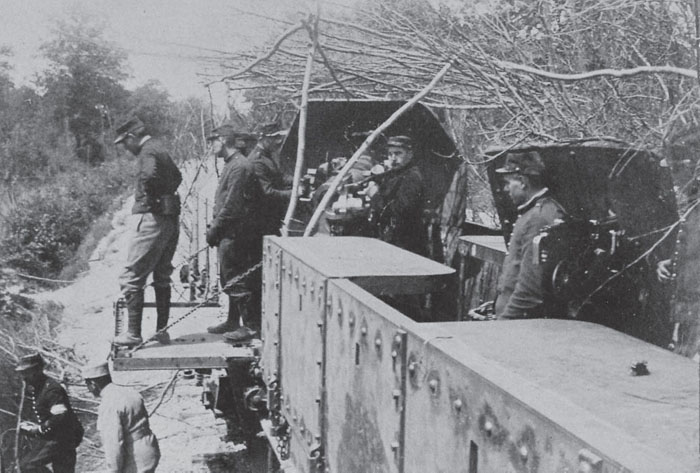
This view shows the 8mm Saint-Étienne Model 1907 machine gun in place. As on the Belgian trains, firing slots pierce the sides of the wagons, allowing us to see the thickness of the armour.
(Photo: Private collection)
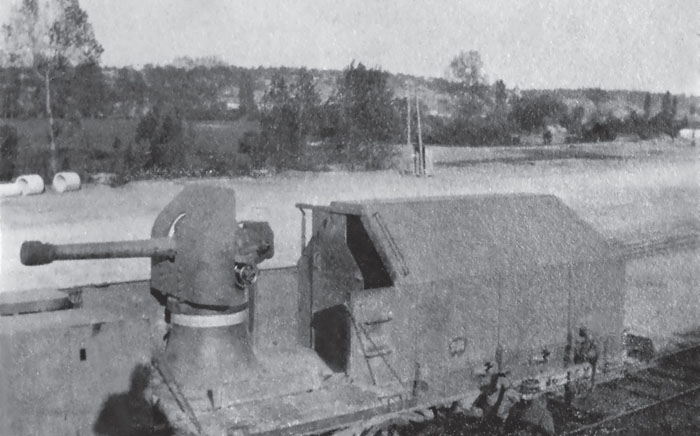
This photo shows the sliding armoured door giving access to the ammunition compartment. Armoured Train No 4 was decommissioned on 2 December 1918.
(Photo: Private collection)
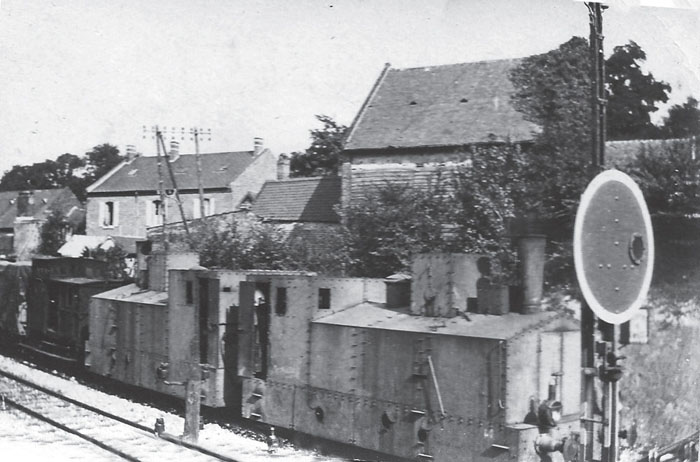
A pair of 0-6-0 ‘Cuckoo’ tank engines, identical to the ones which formed the motive power for Armoured Train No 4 from May 1915.
(Photo: Paul Malmassari Collection)
Although related to the ALGP10 and the ALVF,11 this weapon, of which twenty-three examples were built, belongs in our study because it was completely armoured. The Schneider Works received four separate orders spread out between October 1914 and February 1915, aimed at an entry into service from April 1915 onwards. The gun was a 19cm Model 1870-93 coast-defence gun on coastal mounting Model 1886 PC, in a turret and placed on a 40-tonne chassis of the Est Railway Company. The wagon had an all-up weight of 65 tonnes and could be brought into action in 15 minutes, at any point on the tracks. Range varied from 11.8km out to 18.3km (12,900 to 20,000 yards) depending on the type of ammunition used.
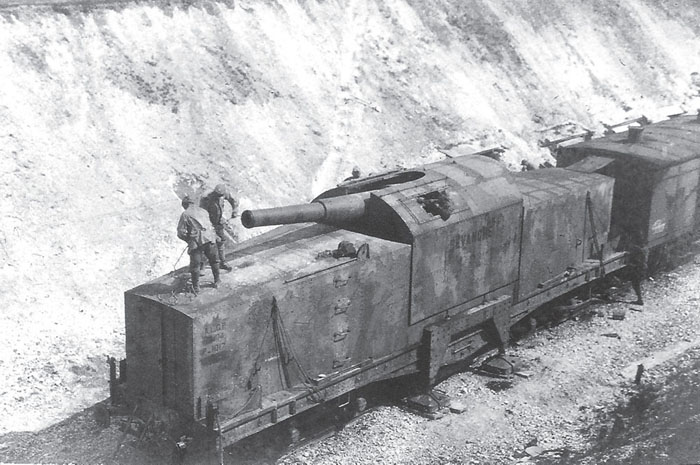
Rail Gun No 1017 La Revanche (‘Revenge’) at Etrun (5km [3 miles] to the west of Arras) in October 1915. Overhead views are rare, and this one in particular shows the armoured shell replenishment corridor and the upper shutters on the revolving casemate. The firing stabilisers are in their lowered position.
(Photo: Paul Malmassari Collection)
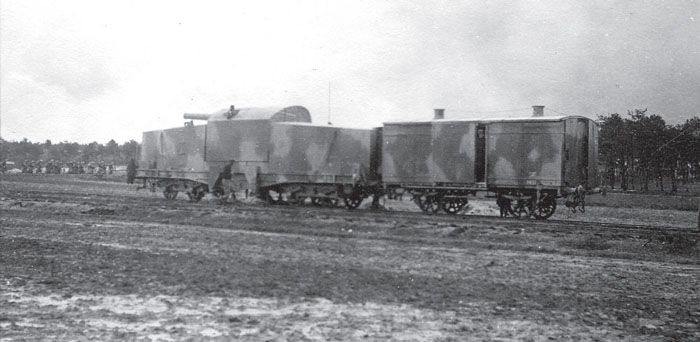
This view is interesting as it shows the configuration of a train with each individual gun battery and its ammunition van separated from the rest of the train for safety reasons. Photo taken at Somme-Suippes on 29 September 1915.
(Photo: Paul Malmassari Collection)
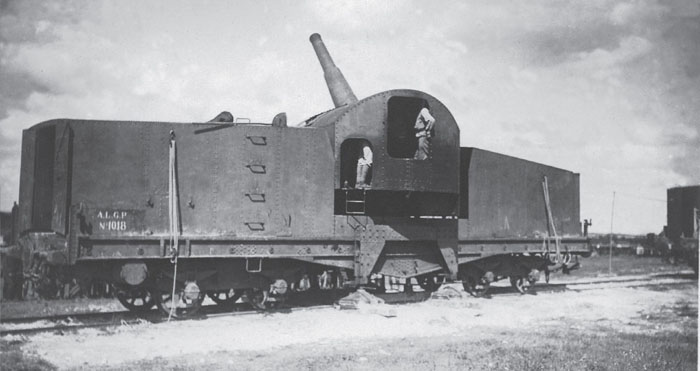
194mm TAZ Rail Gun No 1018 seen in the 1930s. These artillery pieces remained in service up until 1940, when certain units were captured and put back into use, notably twelve examples by the Italians. The openings in the revolving casemate are clearly seen here: on the left for the gun crew, in the centre for the ammunition.
(Photo: Paul Malmassari Collection)
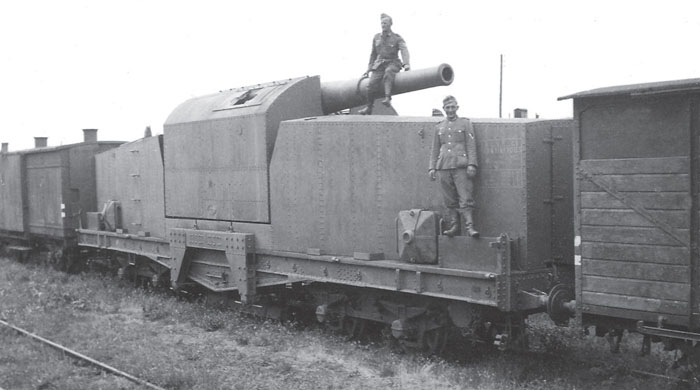
1940: Rail Gun No 1003, one of the twenty-four put back into service, captured by the Wehrmacht and designated as ‘19.4cm Kanone (E) 486 (f)’. The outer stabiliser pads are here seen removed and stowed in the travelling position.
(Photo: Paul Malmassari Collection)
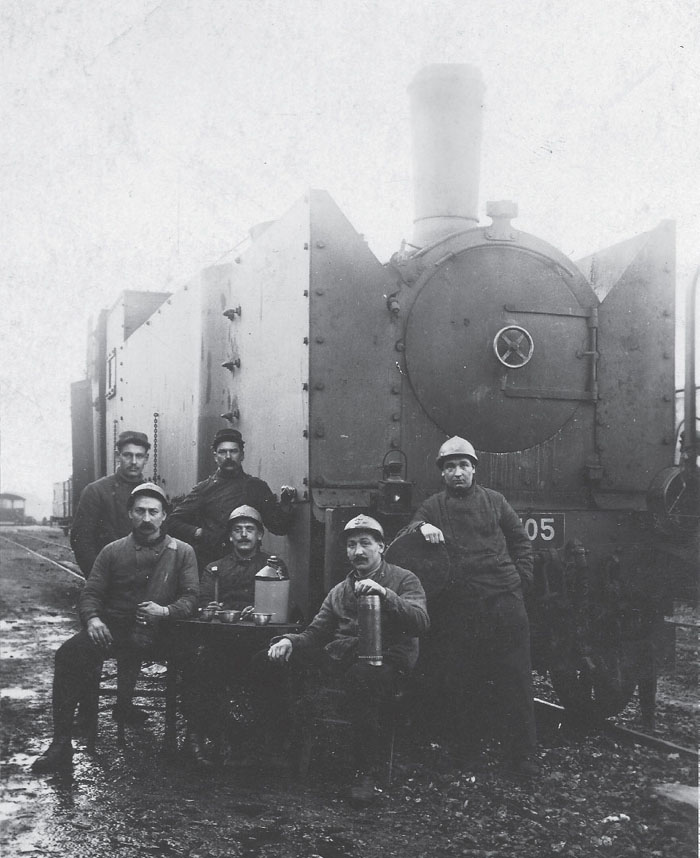
An unidentified armoured engine. The cutaway profile of the front armour is unusual, but the shape of the sliding shutter on the cab side suggests Belgian origins.
(Photo: Paul Malmassari Collection)
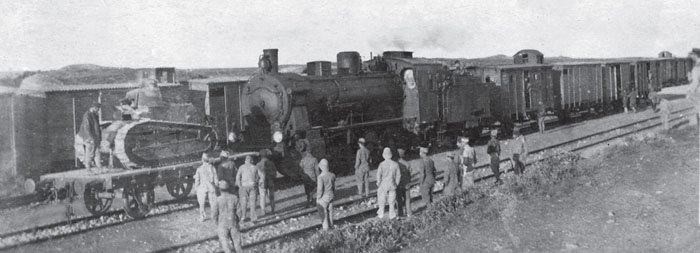
A mystery photo: The Renault FT light tank, on a flat wagon propelled by the Prussian G8 0-8-0, and which is clearly the centre of attention of the French soldiers, is not in transport configuration. On the back of the photo is written ‘Kutina’, which is in Croatia, at the time part of the new Yugoslavia. Perhaps this is a photo taken in the period 1919–20 when Communists, including mutinous regiments, rose up against the government. These revolts were suppressed by Serb troops supported by French units from Salonika.
(Photo: Paul Malmassari Collection)
See the relevant countries’ chapters.
At the end of October 1919, France took over Syria from Great Britain. The Hauran rose in revolt on 20 August 1920. French retaliation was supported by troops carried by trains protected by an armoured train. On 1 October 1920 there were three armoured trains: ‘B’, commanded by Captain Baumann (who was also in overall command of all the armoured trains), ‘S’ and ‘D’ (from the initials of their commanding officers?), which were joined by Train ‘A’ in December. After such a lapse of time it is difficult to identify them, therefore this list may be incomplete. On 13 March 1921, the London Accords put an end to the fighting, but the revolt of the Djebel Druze in 1925 required once more the presence of three armoured trains12 on the lines leading to Damascus.
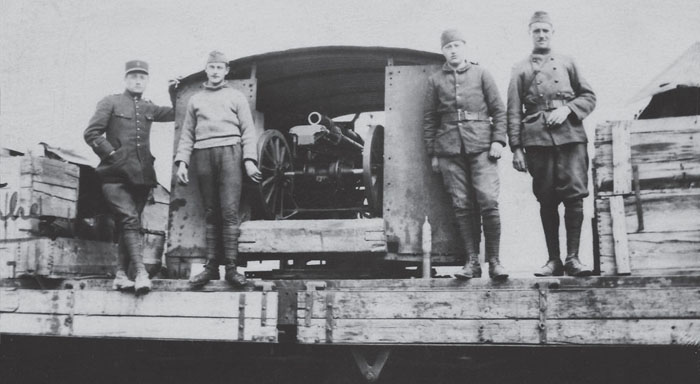
Damascus, 10 September 1926. A 65mm Schneider-Ducrest Model 1906 Mountain Gun, barrel in the rearward position (‘lancé’), is in the turret. The two timber shelters also serve as accommodation. Note the shrapnel shell resting on its base, officially forbidden for obvious safety reasons!
(Photo: Paul Malmassari Collection)
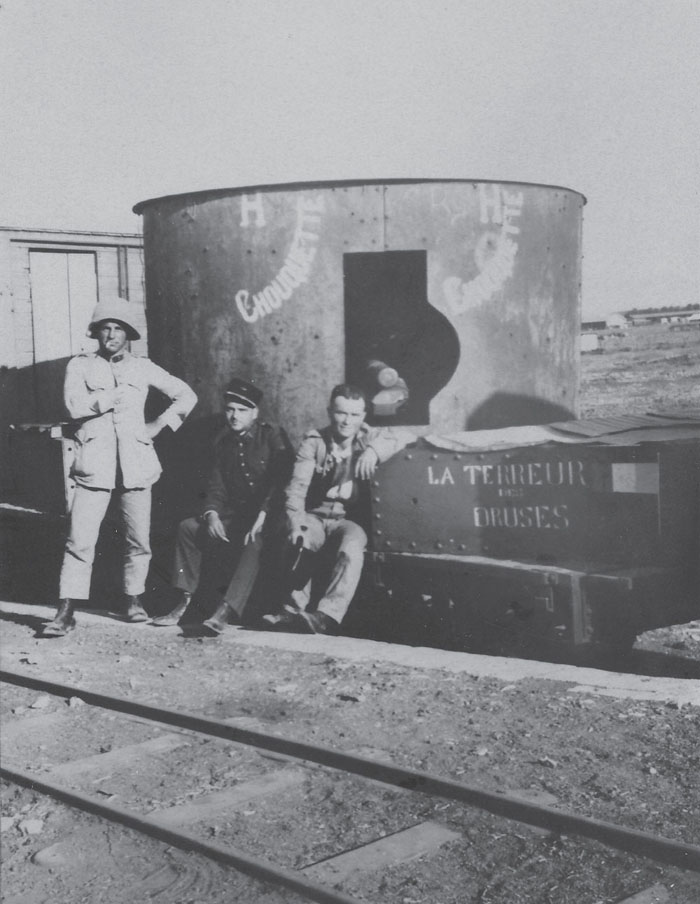
The artillery wagon (65mm mountain gun) of Armoured Train H’. La Terreur des Druzes (‘The Terror of the Druzes’) is perhaps the name of the train, while the turret is named Chouquette (‘Cutie’) a hangover from the 1914–18 War.
(Photo: Paul Malmassari Collection)
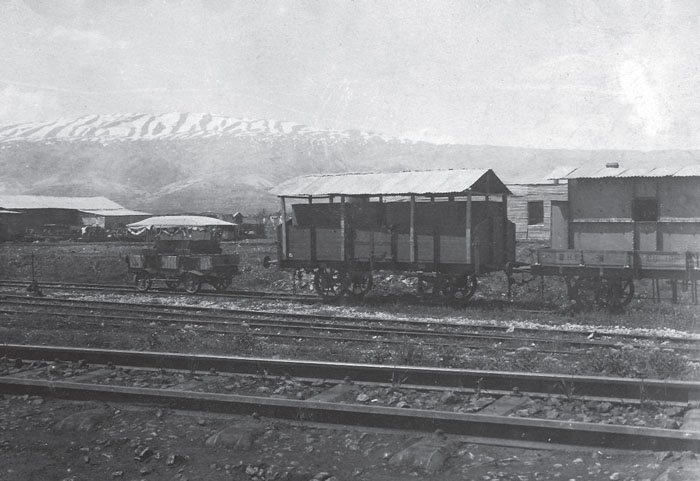
Armoured Train ‘H’ at Rayack, 17 May 1927. On the left is an unarmoured rail trolley. Note the makeshift nature of the protection on the wagons.
(Photo: Paul Malmassari Collection)
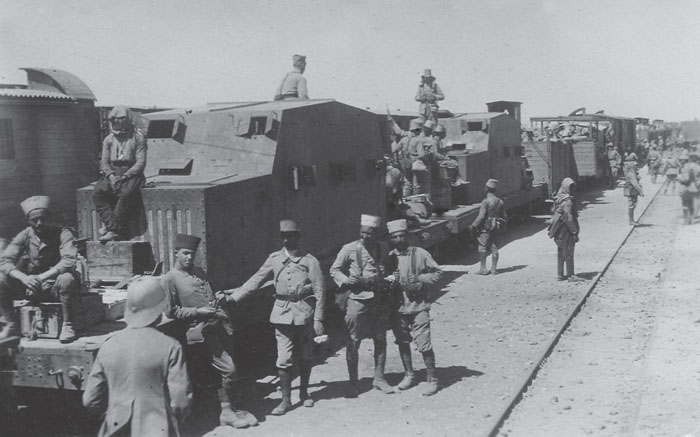
As part of this train photographed at Ezraa in September 1925 we see two armoured wagons assembled by mounting the hulls of captured Ottoman trolleys on bogie flat wagons (see the chapter on The Ottoman Empire).
(Photo: Paul Malmassari Collection)
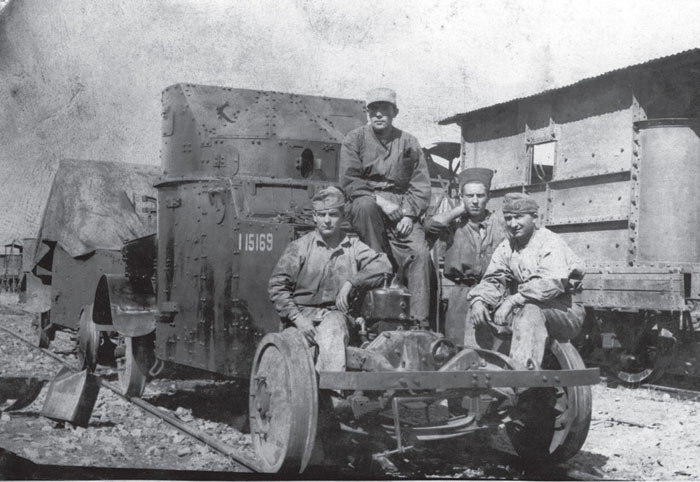
Laffly armoured cars converted into armoured trolleys.
(Photo: Pascal Danjou)
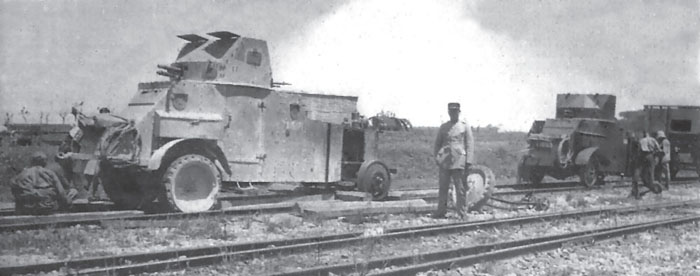
An interesting shot taken in September 1925 which shows the smaller diameter of the rail wheels compared with the original road wheels, which often led to transmission and braking problems, and above all meant the speedometer reading was wrong.
(Photo: Delhalle)
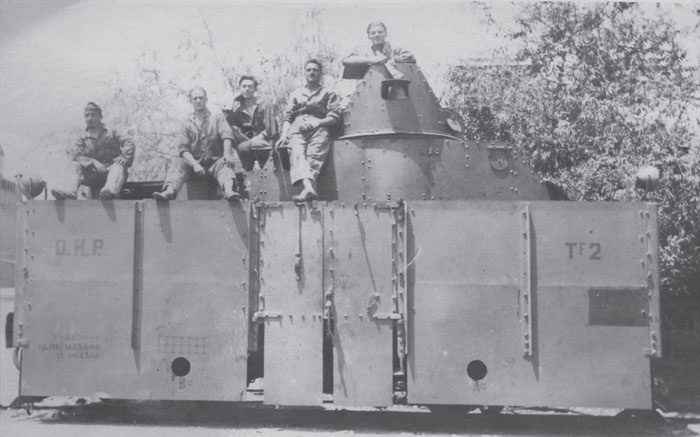
Finally, several traditional rail trolleys were constructed using the Laffly hull as a base, mounted on a flat wagon, complete with all-round armour plates.
(Photo: Paul Malmassari Collection)
For reconnaissance missions, several machine-gun armoured cars were converted into armoured trolleys, firstly by replacing their road wheels, then by surrounding them with armour plates.
After the end of the revolt, these trains were repaired, continually updated and kept in reserve. They would reappear in 1941 during the fratricidal fighting between troops loyal to Marshal Pétain and Gaullist troops.

A view of the other side of Rail Motor No TF2 using a Laffly hull, on the Saïd Naïl-Yeferifa line on 22 March 1931.
(Photo: François Vauvillier Collection)
This period is rich in armoured rail vehicles, but poor in surviving photographic evidence, particularly from 1924 to 1939.13
In the early 1920s it was decided to employ reconnaissance trolleys. A light unarmoured type was ordered in 1924 and an armoured trolley for the standard gauge in 1927. Billard and Renault both proposed design studies for the latter unit, and the Billard proposal was accepted.
Technical specifications (Billard Archives)
| Height: | 2.6m (8ft 6in) |
| Length: | 4.25m (13ft 11in) |
| Width: | 1.90m (6ft 23/4in) |
| Wheelbase: | 2m (6ft 63/4in) |
| Wheel diameter: | 0.6m (1ft 111/2in) |
| All-up weight: | 5 tonnes14 |
| Motor: | Ballot 4-cylinder petrol; bore/stroke 75mm x 130mm; power 13hp at 1000rpm and 24hp at 2000rpm |
| Starting: | Crank handle or electric starter motor |
| Mobility: | The trolley could move equally in both directions, using three gear ratios giving 13, 26 and 40km/h (8, 16 and 25mph) respectively |
| Autonomy: | Sufficient petrol for a range of 200–300km (124–186 miles) depending on the gradients |
| Armour: | 7mm |
| Turret: | Manual rotation |
| Armament: | Turret-mounted 8mm Hotchkiss machine gun, also adaptable on external pintle for anti-aircraft use |
Trials were carried out with the prototype in late 1930, but it seems to have been abandoned in the third quarter of 1932, and disappeared without trace.
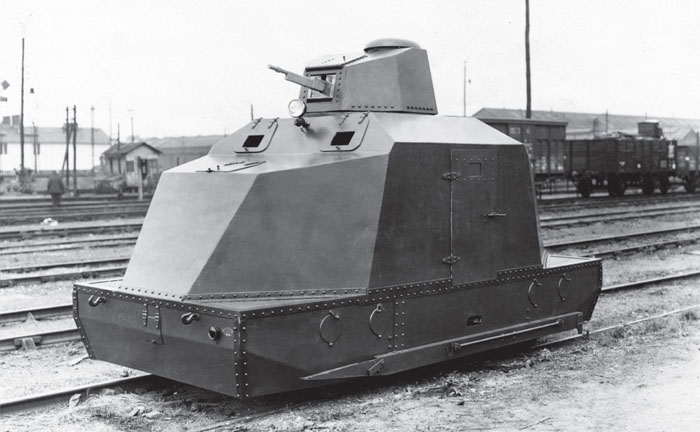
The prototype at the Billard Works in Toul, fitted with a dummy machine gun. Note the re-railing equipment carried on the lower hull.
(Photo: Paul Malmassari Collection)
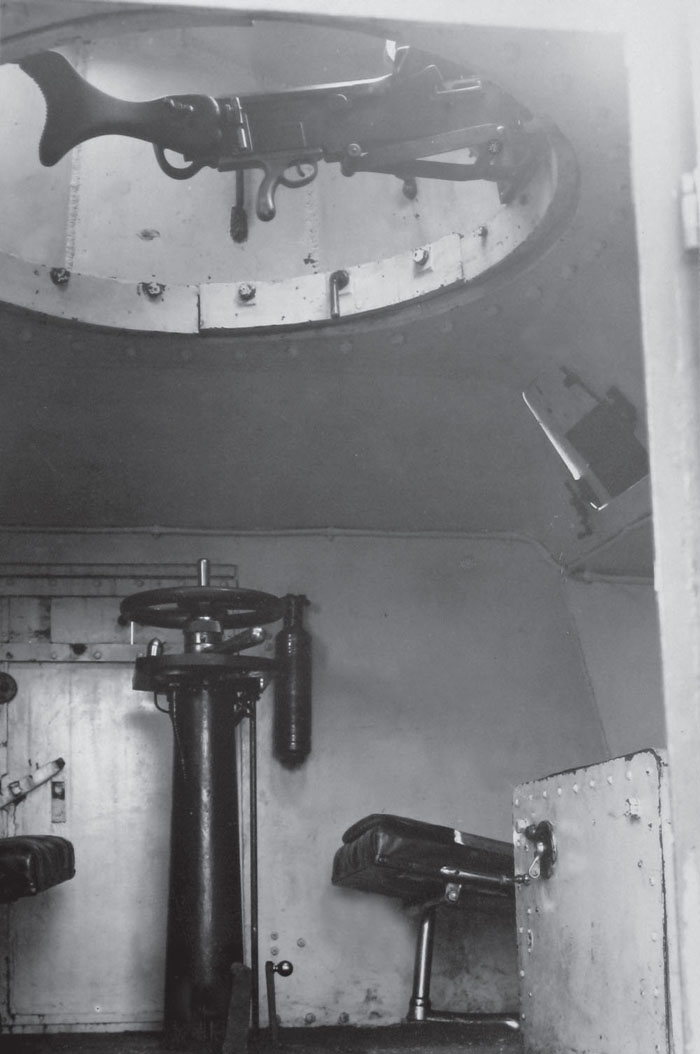
One of the photos taken during anti-aircraft firing trials at Bourges, with an 8mm Hotchkiss machine gun installed.
(Photo: SHD)
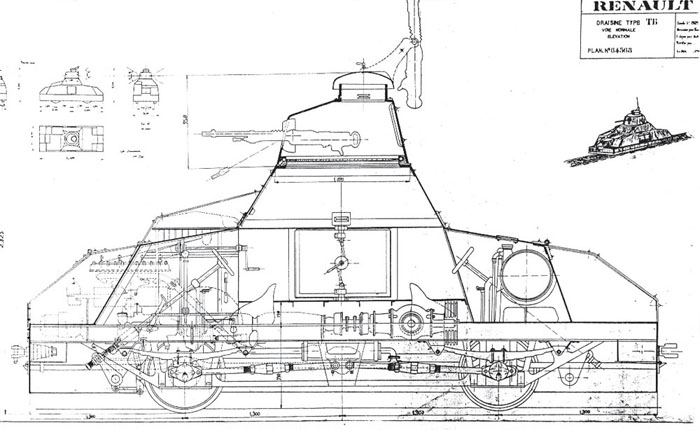
Cutaway profile of the rival Renault trolley proposed for the competitive trials of 1927 and not proceeded with. The weapon is an 8mm Hotchkiss machine gun. The presence of two steering wheels appears strange in a rail-only vehicle, but from the drawing they seem to be connected to the braking system.
(Document: Renault Foundation)
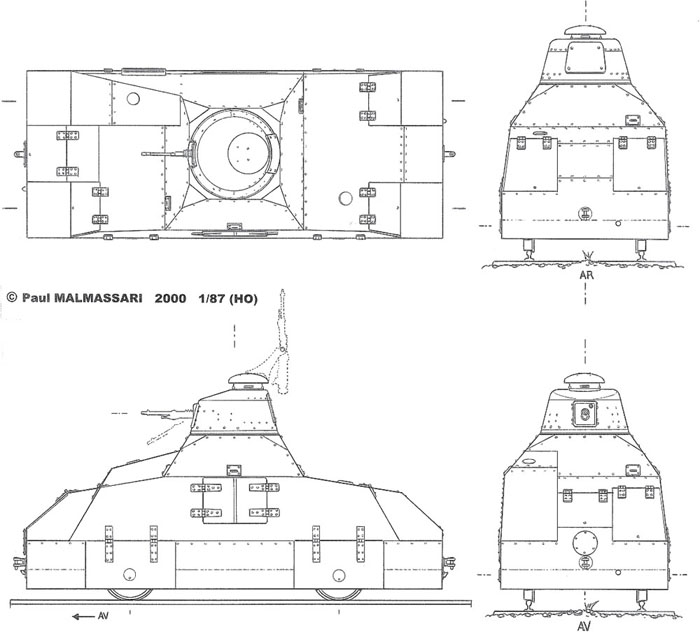
General arrangement drawing of the Renault design.
(Tracing: Paul Malmassari)
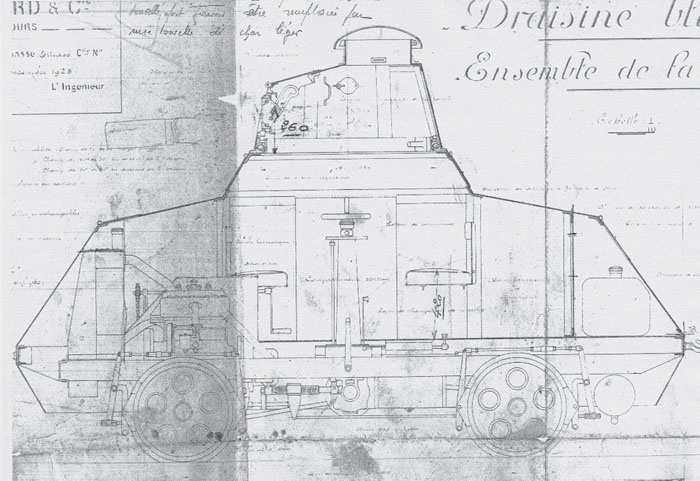
Cutaway profile of the Billard armoured trolley prototype proposed for the design competition in 1927. The handwritten notes suggest the turret was originally to be the type used on the Renault FT tank, whereas a new welded design, with a much lower ventilator cowl, was actually fitted. The machine gun is not shown, and a draughtsman has added a sketch of a possible 37mm TR Model 16 gun as fitted to many FT tanks.
(Drawing: Billard & Company calculations, undated Plan No 1751, Paul Malmassari archives)
An armoured wagon was put into service in 1929 in the Shanghai Concession, probably to act as escort for the International Train. Identification of this wagon is difficult (apart from a French source which indicates there were two wagons, but at Canton), and it is probable it was ultimately incorporated in one or other of the Chinese trains.
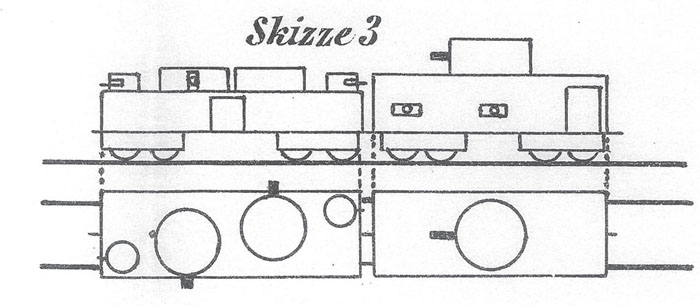
Sketch of the armoured wagons used in China by the French garrison, to a classic design typical of the period.
(Sketch: Militärische Wissenschaft und Technische Mitteilungen)
During the period 1935 to 1937, the French had watched with concern the incidents involving Italians and Ethiopians which had begun in the Spring of 1935, followed by the Italian invasion of Ethiopia in April and May 1936, and the subsequent revolts and incidents of looting. They were obliged to plan for the protection of the railway by means of armoured trains and escorts, which was put into effect in 1938. With the addition of armoured trolleys the protection of the railway at Djibouti continued up until 1944. However, in the absence of surviving photos, we can only record these basic facts without being able to furnish specific details.
During the Spanish Civil War, the French authorities feared incursions from Spanish Morocco. In August 1938 the project of an armoured train was mooted. General Charles Noguès15 estimated ‘that the creation of such an armoured train in times of peace would have a certain usefulness in the case of operations in Spanish Morocco’, and on 23 September, a decision was taken to proceed. This train was to be made up of an armoured 0-6-0 engine (then later a 4-6-0), two Type NN bogie platform wagons, one armed with a 75mm gun (later a 37mm) and the other with a pair of 81mm mortars; two Type UU steel-sided bogie wagons for the engineer element and track repair equipment, plus the command post for the train. Reconnaissance in advance of the train would be carried out by a motorcycle on rails.
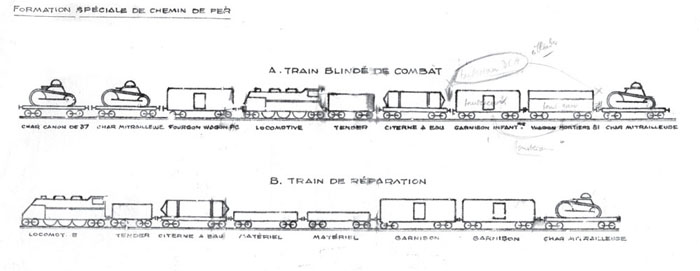
Two possible configurations of the armoured train, prepared by Lieutenant Mainguenaud, commanding officer of the Formation spéciale de chemin de fer, in June 1940. To the best of our knowledge this is the only surviving illustration of this train.
(Drawing: SHD)
The train, built with the help of the Tangier-Fez Railway Company’s workshops, was completed in March 1939, and given the designation Formation spéciale de chemin de fer. It was such a well-kept secret that apparently no photograph of the train was ever taken. Following the military collapse in Metropolitan France, the Formation spéciale was decommissioned on 3 July 1940.16
Several armoured trains of various origins can be identified, in French overseas possessions17 as well as in Metropolitan France18 and during the fighting in Germany. They are listed here in chronological order.
As part of the plan for the defence of Morocco, a train armed by the French Navy with two 75mm guns was stationed on the line to the north of Oued Sebou, and took part in the fighting on 8 November 1942 against the Allied landings, in the Green Beach19 zone.
In this colony 12,000km (7500 miles) from France, the use of ‘armoured trucks’ had already been envisaged back in 1905. Re the armoured trains used from 1940 to 1945, it is difficult to be specific as to their exact number. It appears that in total there were three armoured trains built: one in Tonkin, which took part in the fighting at Lang Son in September 1940 and was destroyed there during the Japanese coup de force in March 1945; a second train in Cochinchina; a third in Cambodia (Phnom Penh) which was deployed during the hostilities between France and Thailand in the period October 1940 and January 1941.
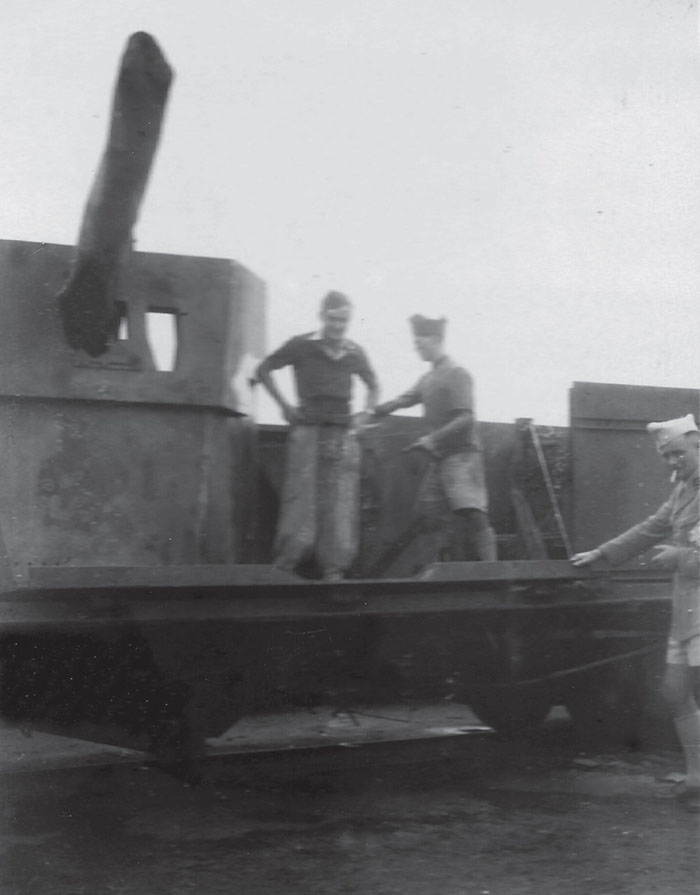
75mm gun wagon of the Tonkin Armoured Train in February 1942.
(Photo: Paul Malmassari Collection)

Photographed by the Americans near Casbah Mehdia to the west of Port Lyautey on 17th May 1943, these two guns were the only ones mounted on railway wagons in Morocco.
(Photo: NARA)
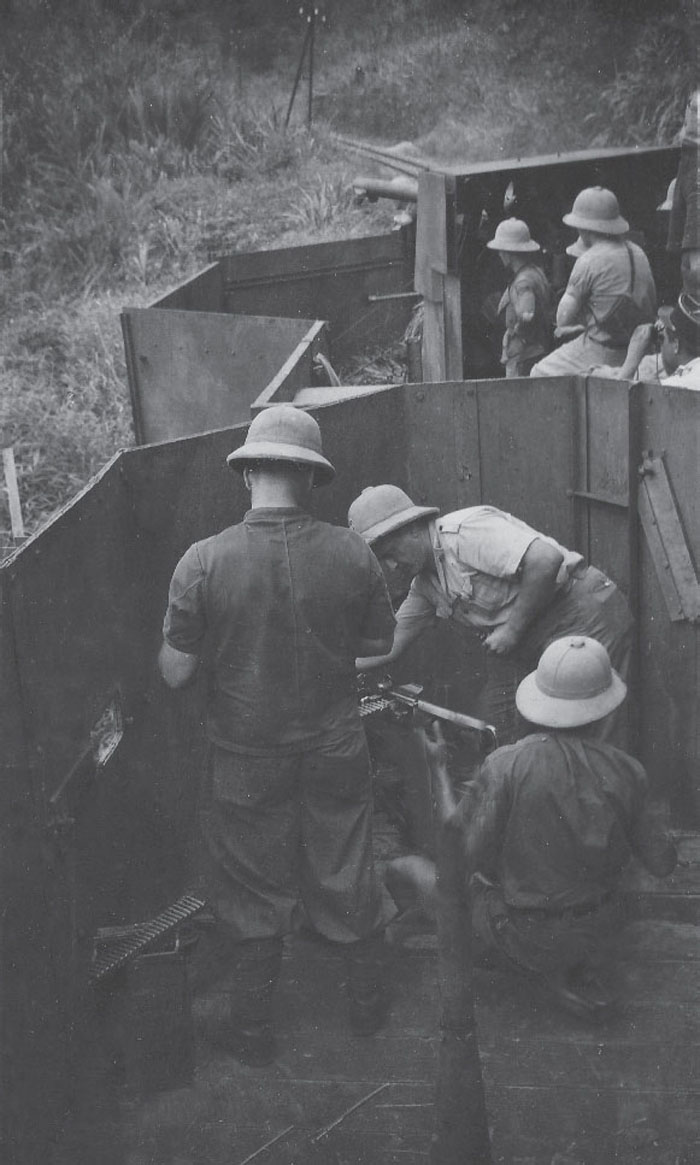
In order to provide as wide a field of fire as possible for the 75mm gun seen in the background, a system of hinged platforms and vertical plates has been installed, forming a large firing platform for the gunners while retaining vertical armour protection.
(Photo: Paul Malmassari Collection)
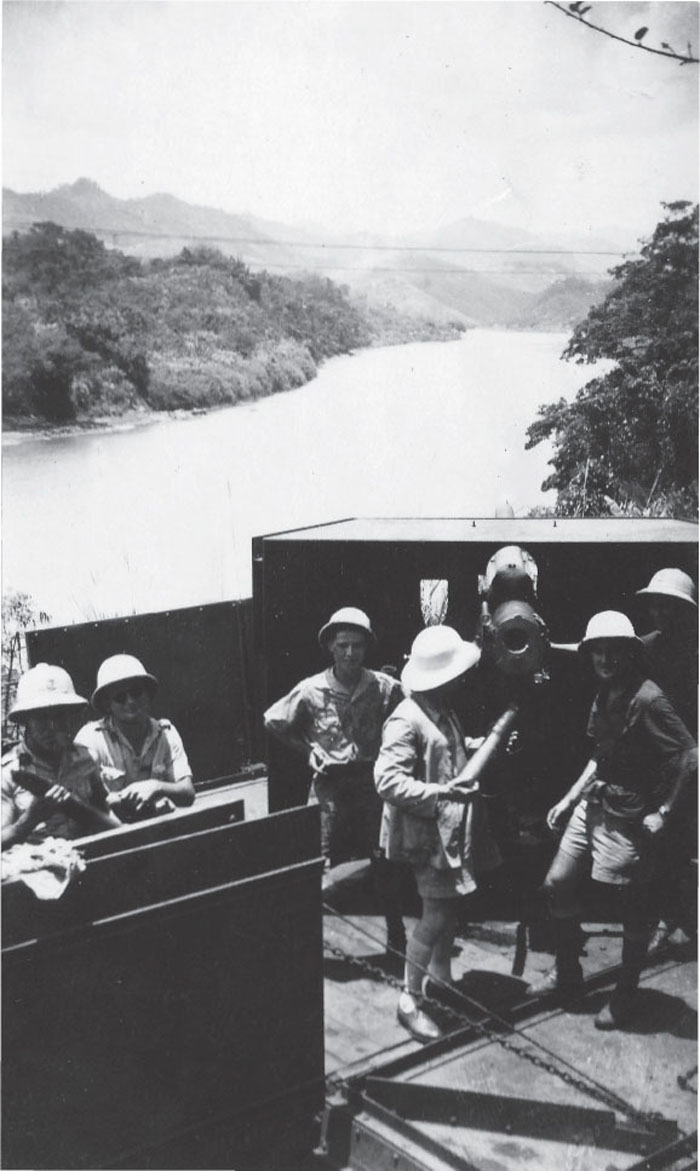
The same train on gunnery exercises at P.K. 210 (Marker Km 210) on 28 March 1942. The railway line runs alongside the Red River. The hinged vertical plates for the sides of the firing platform can clearly be seen.
(Photo: Paul Malmassari Collection)
The armament of these three trains was identical: one 75mm gun, four heavy machine guns, five light machine guns and one 7-tonne tank, probably a Renault FT from the Tonkin Motorised Detachment and the 9th Colonial Infantry Regiment.20
During their entry into Austria in 1945, at Bludenz Station the 5th Armoured Division captured intact a German anti-aircraft train with concrete tubs. Reinforced by a Sherman tank on the leading flat wagon, it was used in reconnaissance sorties on 4, 5 and 6 May.21
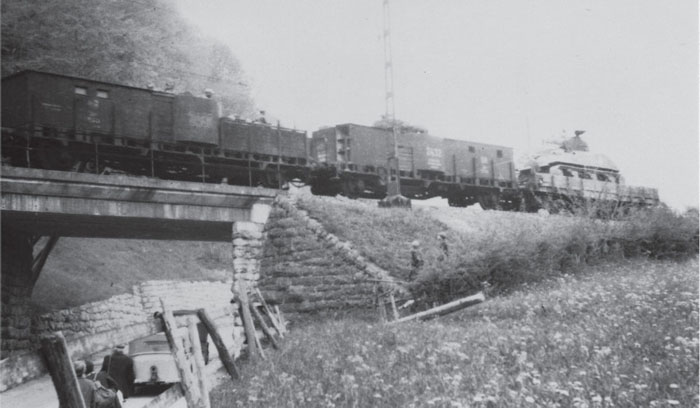
The anti-aircraft wagons with a central concrete tub are instantly recognisable. Aside from the 75mm gun of the Sherman tank on the leading wagon, the armament consisted of 20mm Flak 38 and 20mm Flakvierling 38.
(Photo: Commandant Paqueteau)
As concerned the railway network, the war in Indochina commenced in 1945/46 by reconnaissance runs to assess the tracks (badly worn), the infrastructure (destroyed by American bombing and sabotage by Vietnamese rebels), and the rolling stock (only 40 per cent of the engines remained in a usable state), following which railway traffic was gradually restarted. The Cambodian network was in the best condition. Essentially the railway network was the only viable means of transport in the colony, and its function was a gauge of economic recovery. To ensure success, the running of railway transport was delegated to the military, working in collaboration with tcivilian railway personnel.
Beginning in February 1946, armoured trolleys were sent out in front of the trains. For their part, the Viet-Minh set to work to destroy the network by laying mines, by tearing up the track, by demolishing the bridges and by simply removing the fishplates from sections of rails. To limit the damage, a system of static defence was established, with watchtowers, blockhouses and fortified stations in particular, to complement the active defences of the trains.
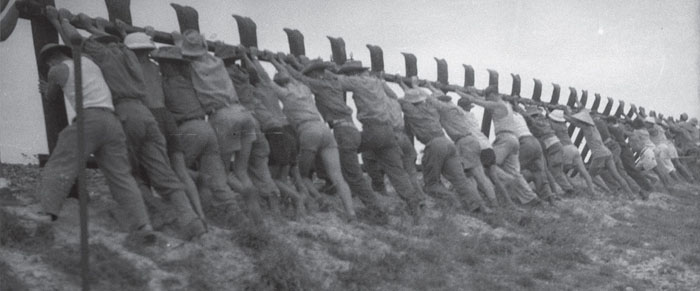
Track disrupted by overturning a complete section: to accomplish this it was necessary only to overturn a part of the track by pulling it with buffaloes or by requisitioning local villagers, and inertia would do the rest. Here the track has been tipped down a slope.
(Photo: Paul Malmassari Collection)
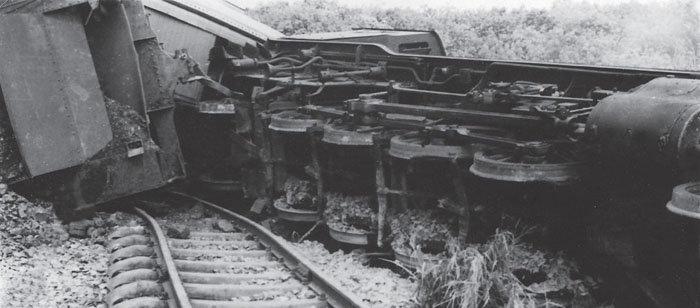
The result of a derailment. Clearly the rims of several driving wheels have been damaged, probably by the explosion of a mine.
(Photo: Michel Protat)
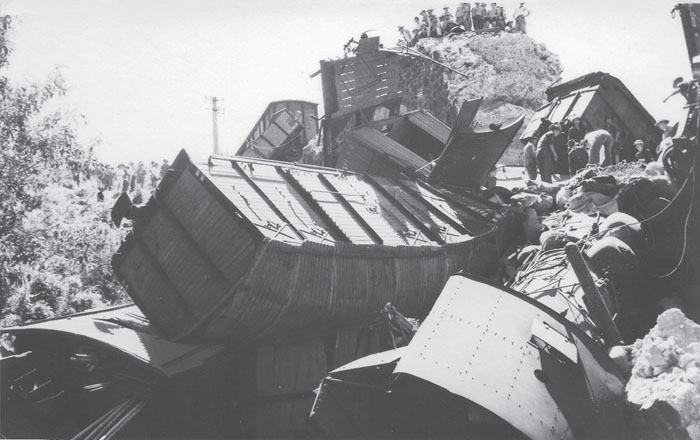
The Baika Viaduct (central Vietnam) was destroyed on 22 June 1953. At top right one can see an armoured wagon, and in the foreground the roof of the engine cab.
(Photo: Le Bris, Paul Malmassari Collection)
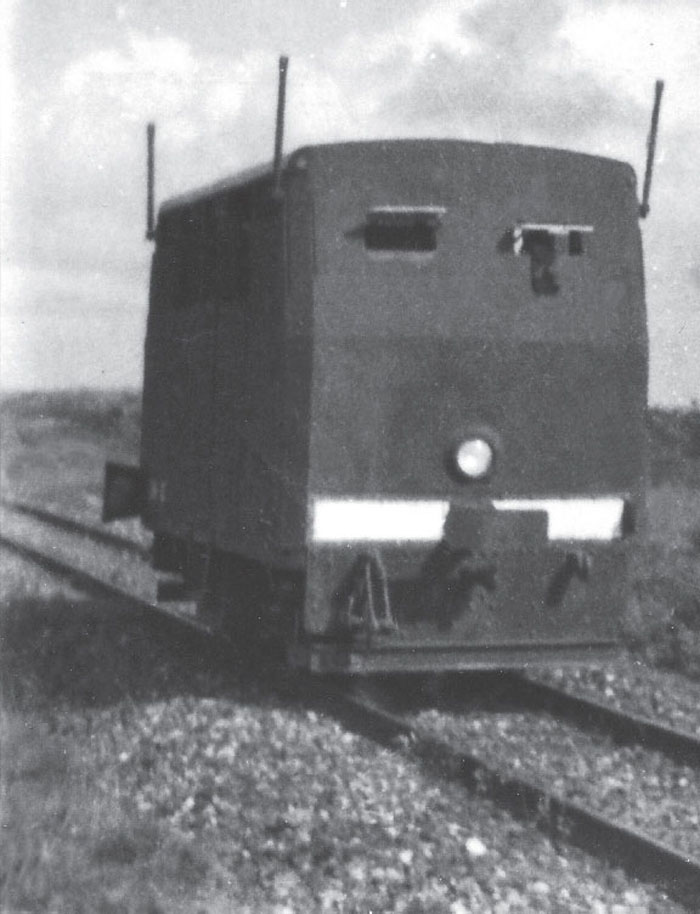
This is definitely one of the four Belgian trolleys, seen here at QuangTri.
(Photo: Major Gricka)
The first step was to deploy armoured trolleys. Initially (February 1946), Japanese trucks (often armoured) and civilian trolleys were recovered. Then road-rail Jeeps (specially adapted to the metric gauge) were used despite their fragile construction and their light armament. The difference in diameter between their 50cm (1ft 7¾in) rail wheels and the 70cm (2ft 3½in) road wheels caused the motors to over-rev.
In view of the deficiencies evident in the existing vehicles, the French Army studied a project for an armoured trolley or rail tractor, with the following modern features: duo-directional, traction capability and turret-mounted guns, but this project would not be built. Equally a study of a Dodge 4x4 on rails was not followed up. In late 1949, four trolleys of Belgian manufacture were received by the CFL and entered service after they had been fitted with armour and armament.
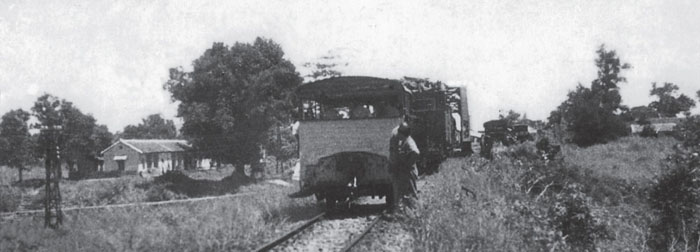
One of the rare surviving photos showing a trolley opening up a route in 1946 or 1947. It is not possible to identify its type.
(Photo: ECPA-D)
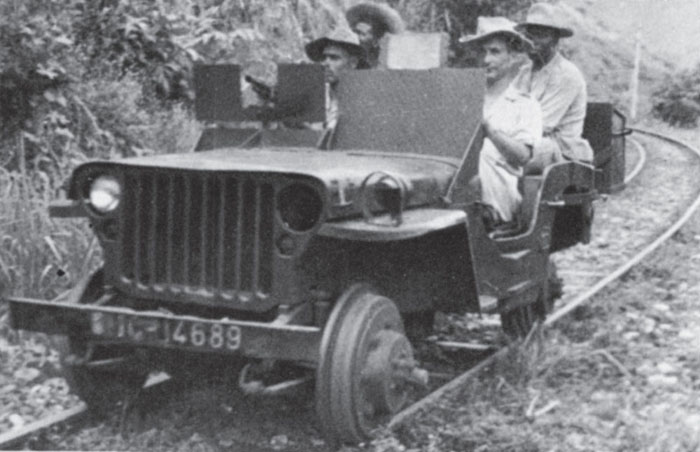
Jeep trolley in the region of the Col des Nuages, Lien-Chien Station in 1947. These machines remained in service up until late 1953. The 1990 book by Patrick Meney, La Rafale, includes a love scene which takes place in a Jeep running blind – a completely hair-brained notion which brings discredit to the book which is elsewhere quite vague.
(Photo: Jean-Gabriel Jeudy Collection22)
The Billard Works delivered at least three Type D 50 D 5 Trolleys for the metric gauge and six others designated D 50 D 5 V.23 Compared with the standard production trolleys, they had a reinforced chassis, a petrol tank capacity increased to 100 litres (26.5 gallons), a floor armoured with 8mm plate, and a more powerful Panhard motor.
The ‘Rafale’ was a traffic procedure involving the grouping together of two to five passenger and goods trains to run one after the other at 20km/h (12.5mph) or 25km/h (15mph) when preceded by an armoured trolley. A ‘Rafale’ would be composed of a ‘pilot’ or ‘main’ train, then trains ‘bis’, ‘ter’ and ‘quater’, so named for the firing of successive rounds from an automatic weapon in a ‘rafale’ (volley or burst of fire). The pilot train would be the most heavily armed (Bofors wagon, armoured car wagon etc).
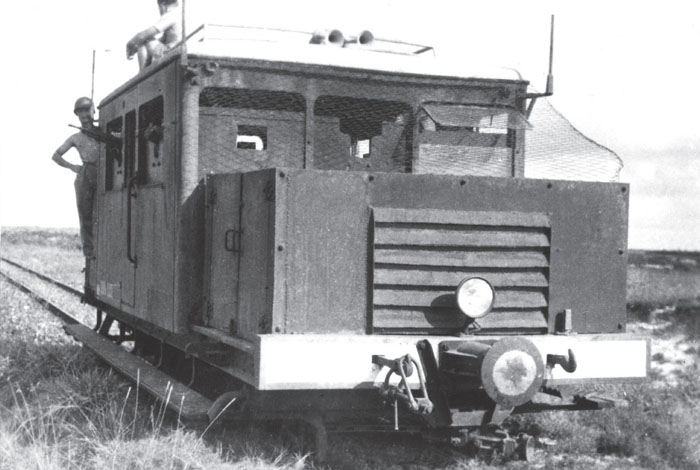
Type D 50 D 5 V trolley at Quang-Tri, fitted with anti-grenade wire mesh.
(Photo: Major Gricka)
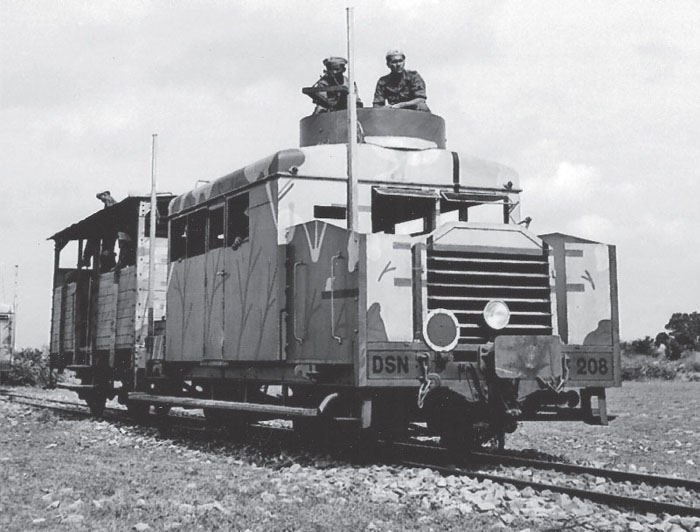
The final version delivered to Indochina, which sports a camouflage scheme, an option rarely used in this theatre and all the more surprising because it features a representation of a railway track, as on certain Soviet or Spanish armoured trains.
(Photo: ECPA-D)

On 24 January 1949, this safety flat wagon, fitted with a cabin armoured with steel rail sleepers, was derailed between Hué and Tourane. On the right is the front end of a Jeep trolley.
(Photo: Paul Malmassari Collection)
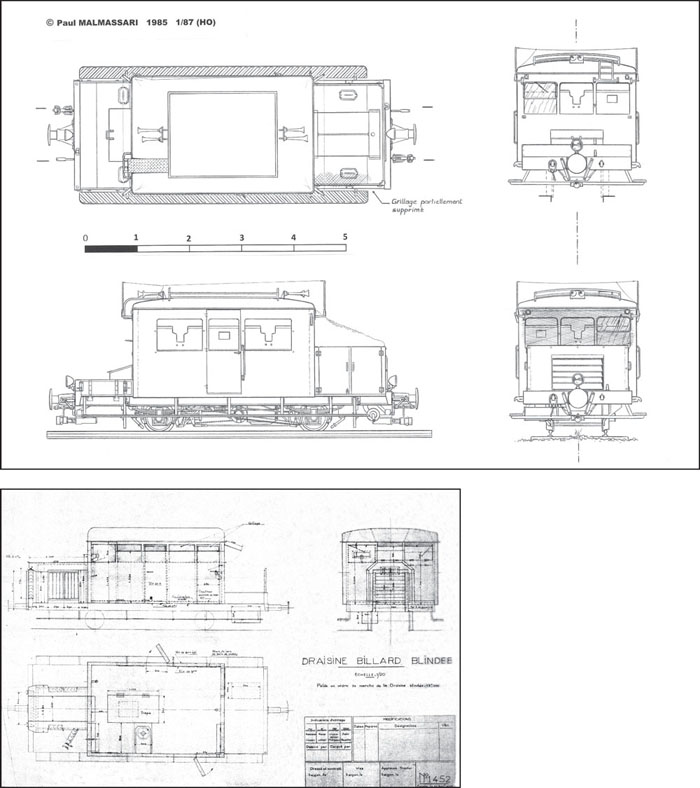
An original drawing of the French Billard armoured trolley for Indochina.
(Builders’ drawing: Paul Malmassari Collection)
But a ‘Rafale’ was not capable of repulsing a major attack on its own, and it was therefore necessary to also deploy patrolling armoured trains. The first of these was built in Saigon and entered service on 16 December 1947. It had an engine and just two wagons. In 1948, the second armoured train was built with the help of the Foreign Legion, and the workshops of the C.F.I., under the command of Captain Raphanaud (who was not a member of the Legion).
The initial protection schemes added from mid-1947 were minimal (even using timber), but were followed by more solid and more efficient armouring. The safety wagon25 at the head of the train and, if possible, at the rear, had an armoured shelter which allowed the detection of track damage and mines.
Heavy firepower was provided by the gun wagons, armed with tank turrets, Coventry armoured car turrets, mortars and AA guns,26 and the following photos show several examples, demonstrating the inventiveness of troops confronted by two adversaries: the Vietnamese enemy and the scarce resources allocated by the home country in the process of reconstruction following the Second World War.
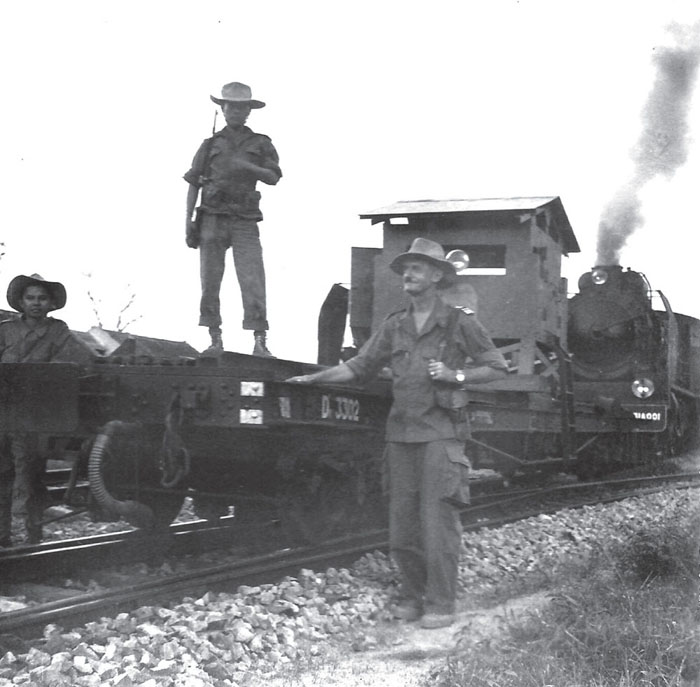
Type D wagon serving as control wagon for the pilot train of the Rafale. These platform wagons began to enter service in January 1947.
(Photo: Le Bris, Paul Malmassari Collection)
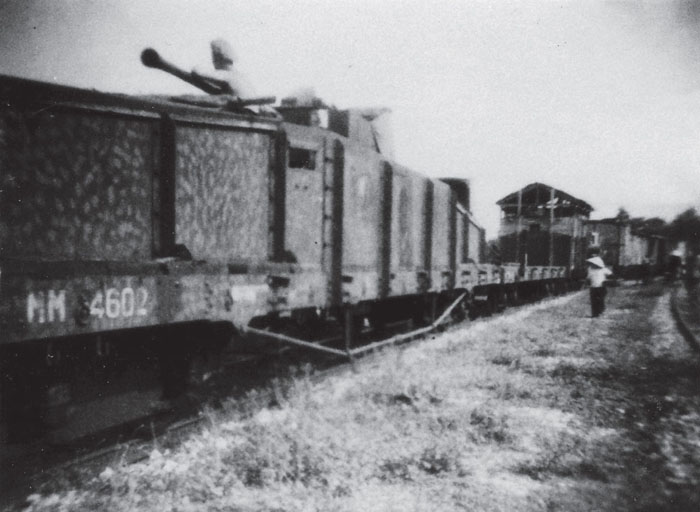
Type MM Wagon armed with a 40mm Bofors, put into service on 5 April 1947 on the line to Nha Trang. It was placed at the tail of the train and the flat wagon which followed normally ran unloaded.
(Photo: Le Bris, Paul Malmassari Collection)
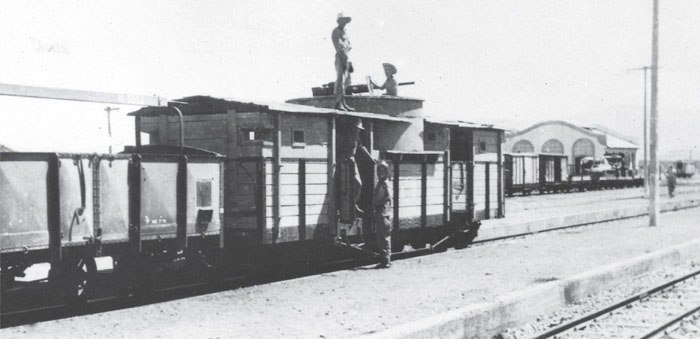
Another version of the Bofors wagon which bears more than a passing resemblance to the Flak wagons with their central concrete tub.
(Photo: Michel Protat)
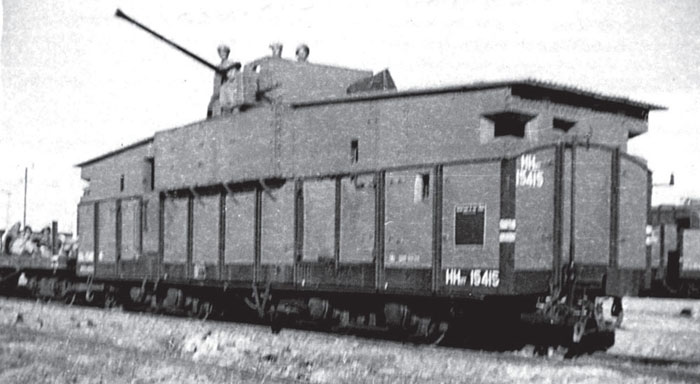
A third version of the Bofors wagon, here built up inside a high-sided Type HHff No 15415 bogie wagon.
(Photo: Yves Bernard)
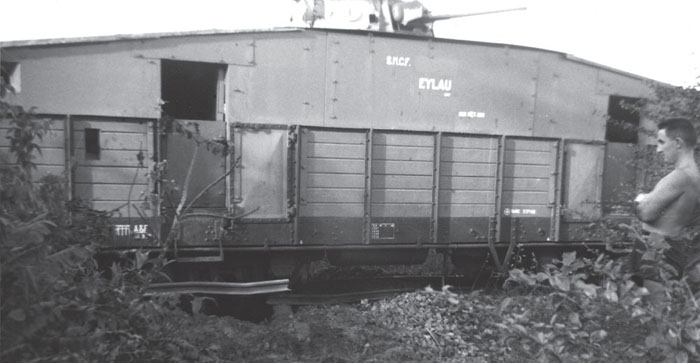
Type HH27 wagon with the turret of a Coventry armoured car, in the armoured train of the 4th Regiment, who had the habit of christening this ‘rail tank’ with the name of a memorable battle.
(Photo: Yves Bernard)
The use of turrets from tanks or armoured cars had two advantages: on the one hand they were protected by armour 14mm thick, superior to the available armour plates, and secondly they allowed all-round traverse of the arms carried. On the Cambodian rail network, ex-Japanese Type HA-GO tanks were also used (see the chapter on Japan). For indirect fire, 60mm then later 81mm mortars were used, which allowed the gunners to hit the enemy firing from trenches or behind cover. In the case of trains following one closely behind the other, in the ‘Rafale’ configuration, they were also able to lob mortar rounds over the preceding train(s).
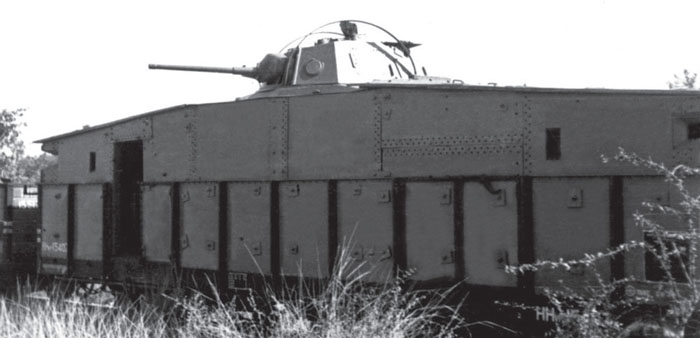
Type HHyf wagon built around a Coventry armoured car, with reinforced sides. The curved bands serve to deflect the cables stretched between trees to decapi-tate the unwary.
(Photo: Yves Bernard)

Recoving the wreckage of a Coventry wagon which has been blown up by a mine. Note that while the turret is standard (less its 2pdr gun), the armoured car hull has been lightened as much as possible.
(Photo: Yves Bernard)
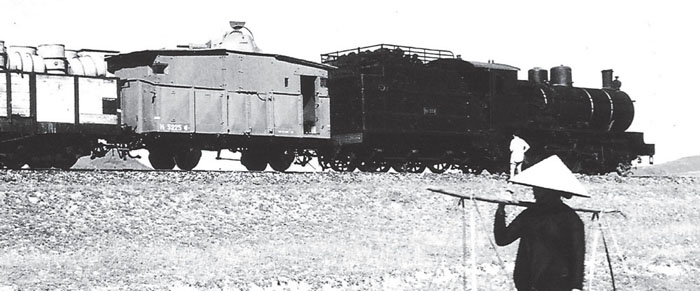
One of the four Type H28 wagons built in June–July 1949 with APX turrets from H 39 tanks (37mm Model SA38 gun), seen here on the Mandarin Road between the Col des Nuages and Tourane. The H 39 tanks had been captured in 1940 then re-used by the Germans who had modified the commander’s cupola.
(Date unknown, photo: Paul Malmassari Collection)
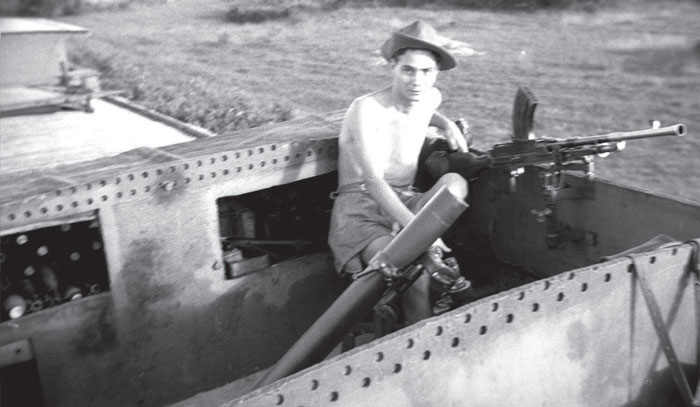
A fine shot of a mortar wagon (here a 60mm mortar, with a .303in Bren LMG), showing also the ammunition and equipment storage. As the mortars were mounted in elevated casemates, the remainder of the wagon could be put to other uses, and it is therefore difficult to distinguish between the different types of armoured wagons by appearance alone.
(Photo: Michel Protat)
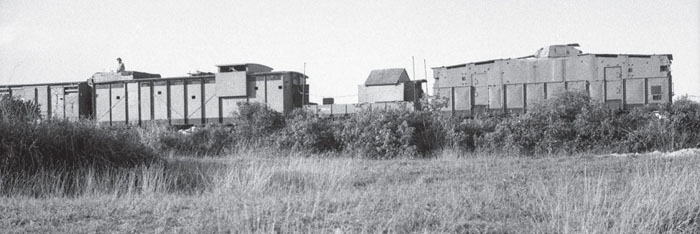
In this view of an armoured train in central Annam, the intermediate flat wagon carries a shelter surrounded by aerials. To the right, a Type HH wagon is armed with a Coventry turret and on the left is perhaps a control van.
(Photo: Michel Protat)
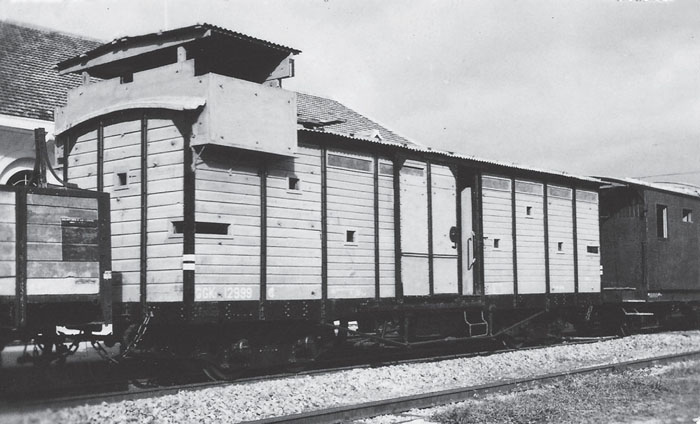
GGc van of the first type to be built, in armoured train Sud of the 2nd REI (2nd Foreign Legion Infantry Regiment). The wooden exterior is doubled by an internal metal skin.
(Photo: Le Bris, Paul Malmassari Collection)
Communications, whether to command posts, air support and stations or to other trains in the ‘Rafale’ and to the sections of the same train, were from the command wagons. In Indochina, several types of bogie wagon and van were used, all with a built-up casemate, and which from the outside were difficult to distinguish from the mortar wagons.
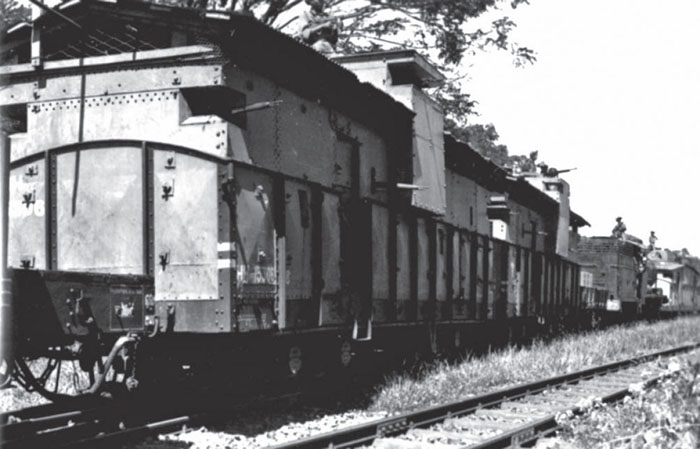
HH 15306 bogie wagon in Cochinchina with a central casemate for a mortar pierced by loopholes for firing fore and aft along the line. On the second wagon is a MAC 31 machine gun.
(Photo: Promotion Victoire via General Nicola-Vullierme)
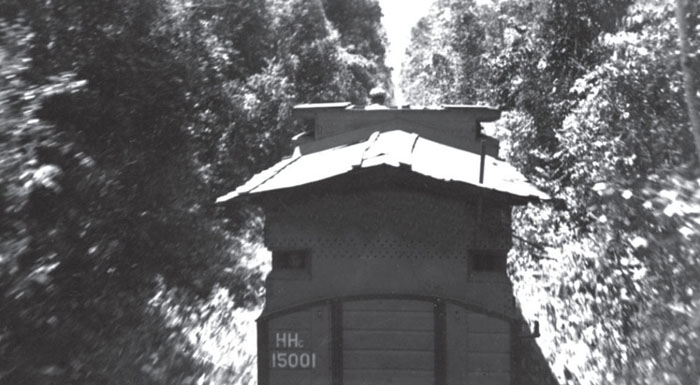
This shot gives a good idea of the dangers faced by the train crews, with dense vegetation which allowed the Viet-Minh to approach to within a few yards of the trains and then quickly vanish.
(Photo: Promotion Victoire via General Nicola-Vullierme)
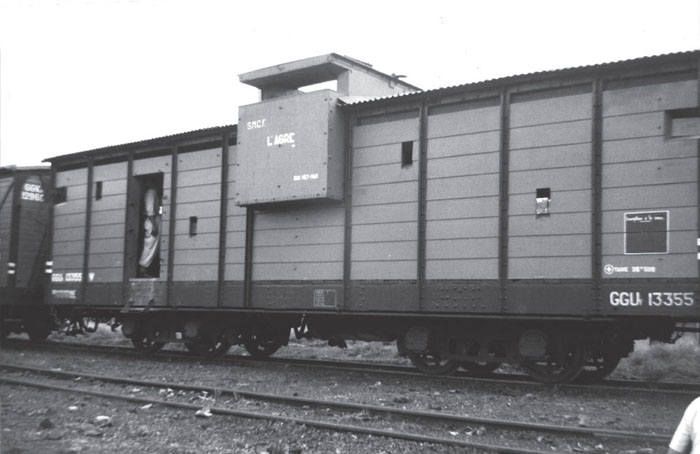
An armoured van, well-supplied with firing loopholes which were always found at the corners, and which could be closed from the inside. On the casemate roof one can see opening vents, probably sheltering a mortar.
(Photo: Yves Bernard)
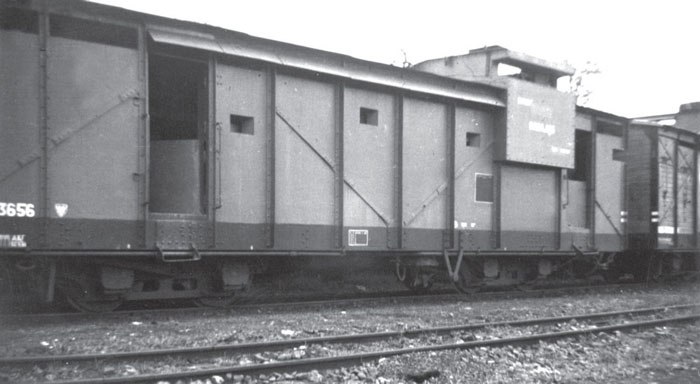
Despite the increased difficulty of re-railing these bogie vans and wagons after a derailment, their much longer hull sides allowed for increased firepower.
(Photo: Yves Bernard)
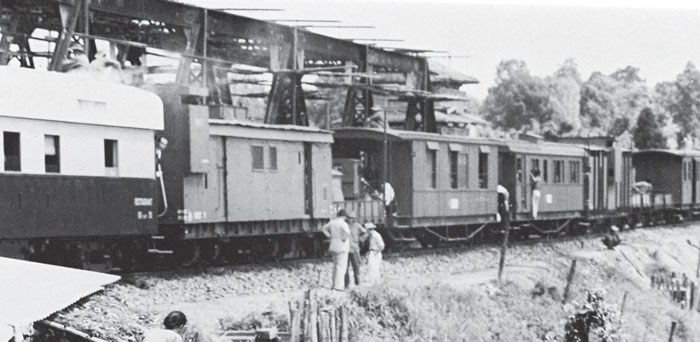
A typical view of a Rafale, with the armoured wagons inserted in a random manner in the middle of the train. The escort coach on the left is Type GGy No 12803.
(Photo: Institut du monde du travail)

The armoured train of the 4th Dragoon Regiment in 1951–2, showing a classic wagon layout (which could be quickly varied). The engine is out of sight to the left, in front of the tank wagon, and from a distance the armoured train presents an appearance quite similar to that of a civilian rake.
(Photo: Yves Bernard)
On 29 March 1947 an insurrection began, which included the railway network among its targets. The main railway stations were fortified and ‘protected trains’ carried out patrols on the TCE and the MLA.29 Although lacking the firepower and protection of contemporary European armoured trains, they ensured the free circulation of traffic up until the end of the insurrection in 1948.
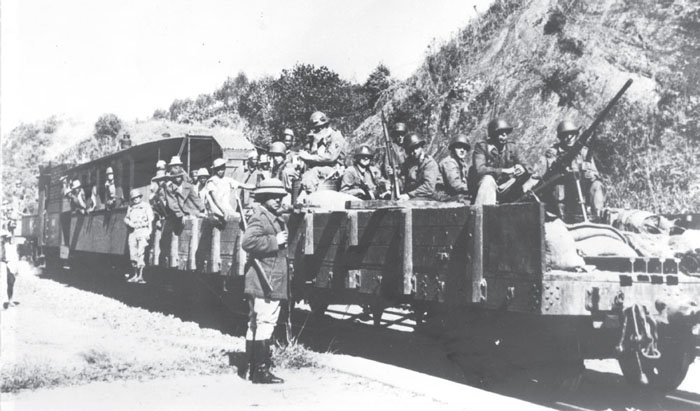
Quite adequate for fighting the Madagascan rebels, these patrol trains were far removed from the combat potential of the Russian and German types of the recent Second World War. The machine gun on the leading wagon is a Browning .50 Cal (12.7mm).
(Photo: Private collection)
The French railways in Algeria were permanently threatened by rebels, and the seriousness of such threats varied from year to year. The Press regularly alluded to the need for armoured trains, for example the edition of 5 July 1896 of Le Monde du travail de l’Afrique Française, in which a certain Francis Laure considered the use of armoured trains to be the only method of overcoming the Touaregs.
The war in Algeria began on 1 November 1954. At first the insurgents concentrated their attacks on individuals, and for the first year of conflict the communication infrastructure was left unaffected.30 Then the attacks against the railways began in earnest, in the manner typical of pure terrorism. As Algeria was a French Department, the authorities could not let the insurgents gain the upper hand over the circulation of passenger and goods traffic. There were over 4500km (2800 miles) of track in use, with regular timetables and published operating procedures, which allowed the terrorists to plan their attacks, but at the same time the economic prosperity of Algeria depended on its railways.
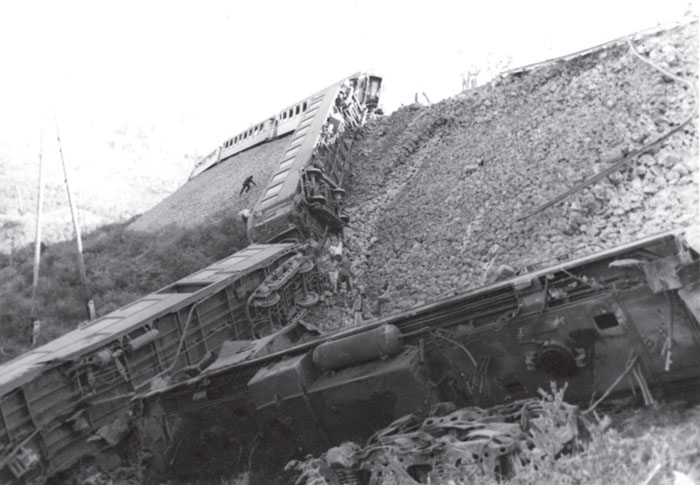
Derailment of a passenger train by a mine on 22 September 1957 at Km Post 135 + 200 on the Oran-Oujda line.
(Report of the Police Aux Frontières at Tlemcen)
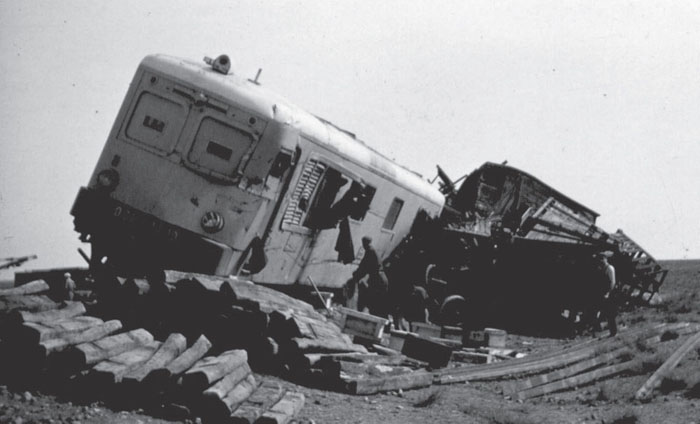
An example of the armoured window openings applied to a derailed de Dietrich diesel-electric 060 YDA railcar of the S.N.C.F.A. (Algerian National Railway company).
(Photo: Nepveux)
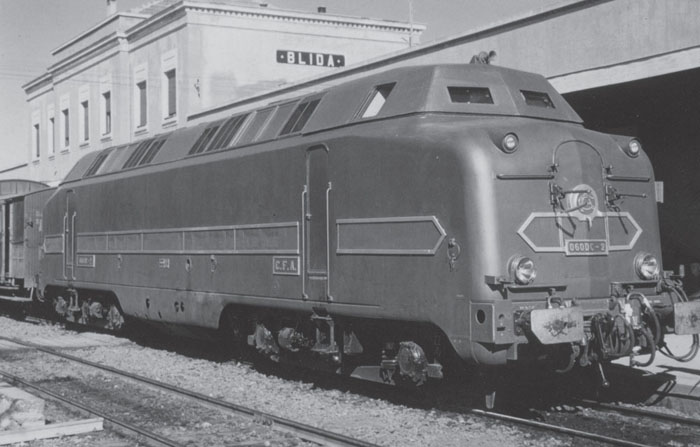
Diesel locomotive 060DC-3 seen at Blida in September 1957, with all-round armour protection for the driving cabs.
(Photo: Gérard Pouillé)
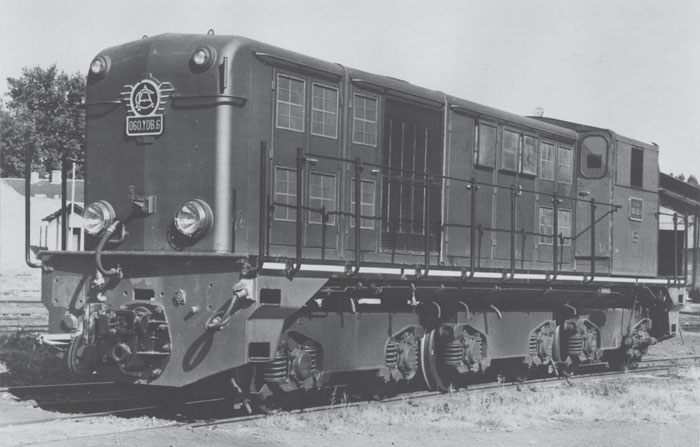
Algerian Railways Alsthom diesel-electric locomotive BBB 060 YBD bearing the company’s crest. The cab is armoured, and the holes in the buffer beam indicate that the locomotive was originally fitted with buffers for use on the main line, before being modified with central coupling knuckles.
(Photo: Private collection)
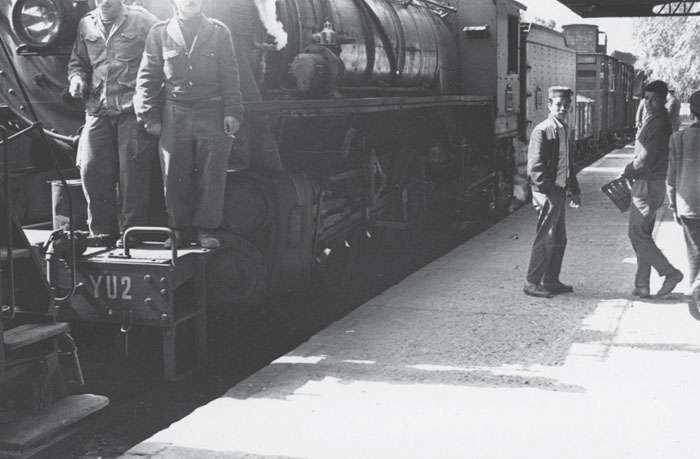
A rare shot of a steam engine on the metre gauge, a 2-8-2 named MacArthur.
(Photo: Paul Malmassari Collection)
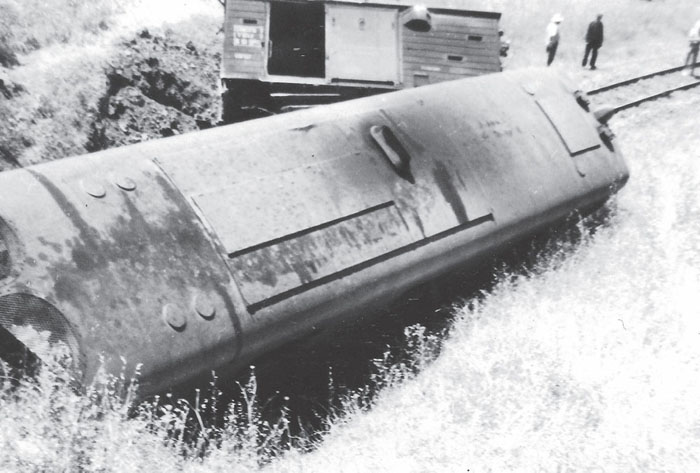
An escort van partially-armoured with 7mm plates, lying beside a de Dietrich railcar after a successful ambush.
(Photo: ECPA-D)
The use of vehicles repatriated from Indochina was considered for the narrow-gauge lines.31 Several narrow-gauge armoured trolleys had been recovered and in early 1956 they were undergoing overhaul. They would serve as sweepers preceding trains. The driving cabs of the locomotives and railcars were also fitted with armour protection, commencing with the region around Constantine. In addition, a certain number of wagons and vans included in the rakes of trains operating in danger zones, or attached at the tail end of mineral trains,32 were also armoured.
In November 1955 the defence of the railway network was set in motion in earnest, with the creation of a battalion-sized specialist unit, supported by military specialists from the Algerian Railway Company. This move allowed the creation of an escort unit of Scout Cars (six pairs of coupled Scout Cars and six groups of trolleys of the C.F.A.), and three train escort units (or twelve sections, in specialised wagons of the C.F.A.). In summary, the fight against saboteurs was the role of the Army (surveillance and intervention by armoured train), and sweeping the track in advance of trains fell to the C.F.A. using the Billard Trolleys, the Dodge 4x4s on rails and the Scout Cars on rails.
By way of an example, the 587th Train Battalion was charged with three missions. The first was to ensure the regular running and the protection of the transport system. The second was to employ mobile means of sweeping, surveillance and intervention. The third and final mission consisted of supplying escort groups of up to a dozen men led by an NCO,33 initially in wagons protected by sandbags or anti-mine carpets then, from February 1956, in armoured wagons.
What means were available to these units? In chronological order, the first seven Billard Trolleys were put into service at the end of 1955. The initial experience gained with these was used to improve subsequent vehicles.
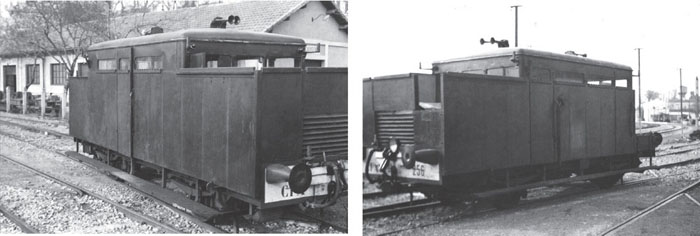
Two views of the first Billard trolleys, with armour protection which followed the form of the basic vehicle. The armoured grille featured at the front end of all these trolleys. The opening to the upper left of the grille allowed a wider field of vision to the driver. Whether military or civilian, all these armoured trolleys carried a C.F.A. serial number.
(Photos: Paul Malmassari Collection)
Next, M3A1 Scout Car trolleys were introduced. They had been converted by the workshops of the C.F.A. to run on rails.34 Well armed but slow and lightly armoured, their main drawback was that they had only one reverse gear. The solution was therefore to couple two Scout Cars back-to-back, or to pair one with a Billard Trolley.
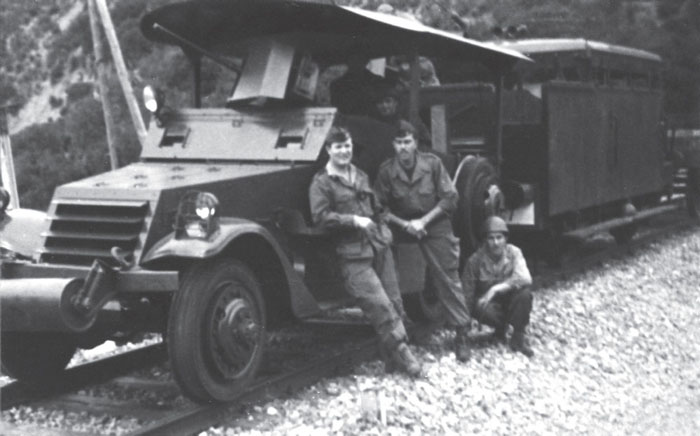
To make up for the lack of a turntable, this coupled unit of Scout Car and Billard trolley nicknamed the ‘Escargot’ or ‘Snail’ (by analogy with the train called ‘Tortue’ or ‘Tortoise’) functioned with the Scout Car at the front driving forward, and with the gearbox in neutral when towed in reverse.
(Photo: Tallabardon)
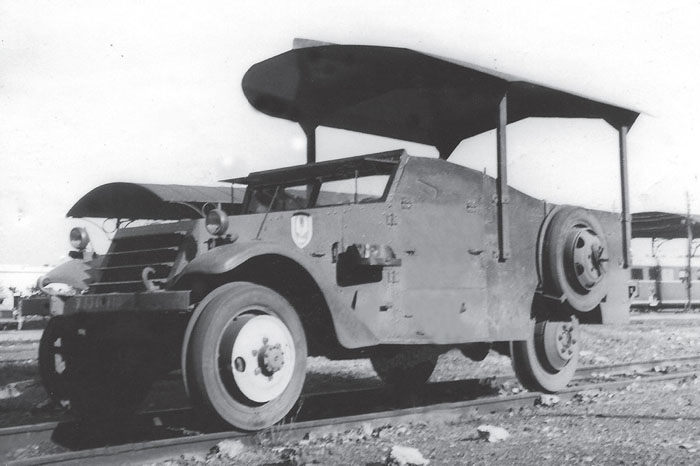
The front wheels of this Scout Car trolley have been fitted with additional armour. The shield is that of the 587th Transportation Battalion.
(Photo: Paul Malmassari Collection)
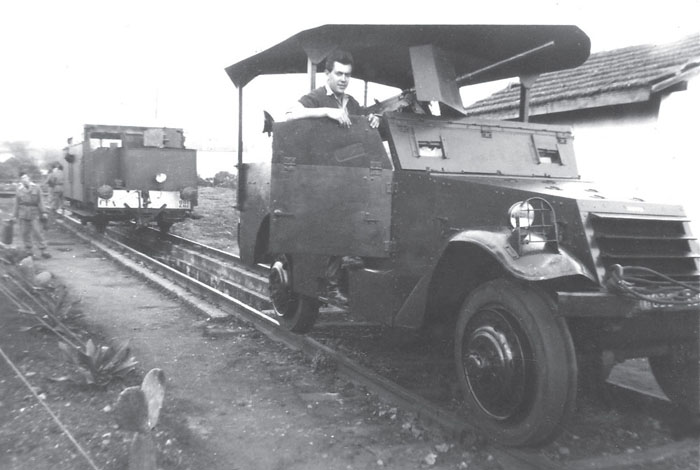
The unditching rollers appear to have been removed during the final years of the war in Algeria. Note the .50 Cal (12.7mm) machine gun which is the main armament. The secondary armament of the Scout Car was either one or two .30 Cal (7.62mm) US machine guns.
(Photo: Paul Malmassari Collection)
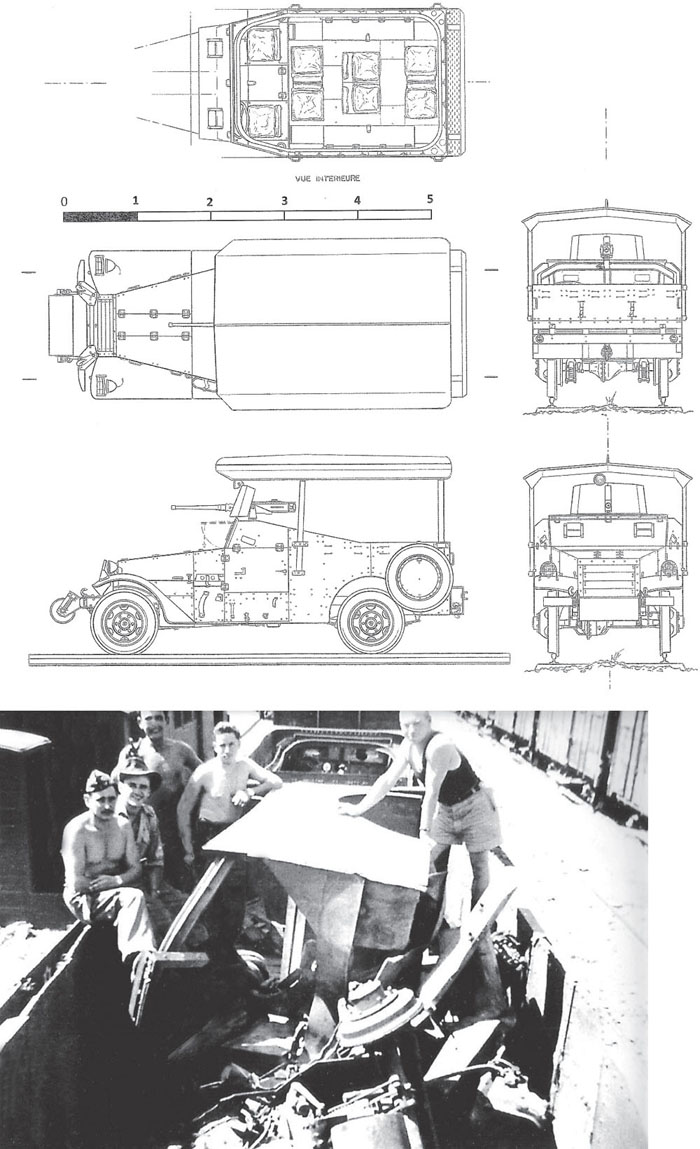
The sad fate of a Scout Car, its wreckage recovered in a bogie wagon.
(Photo: Guy Chabot, 3rd Zouaves Association)
The Dodge Weapons Carrier WC51 converted to a railway trolley was used from February 1956 up until the end of the war. The rail conversion had been carried out for the C.F.A. and for the armed forces by two firms: VERARO35 from 1951 and Desquesnes & Giral.
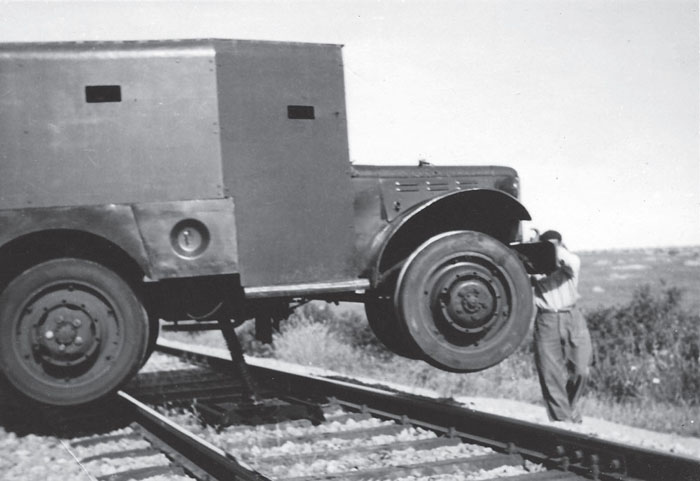
An early version of the Dodge Rail Trolley, with no side door.
(Photo: Paul Malmassari Collection)
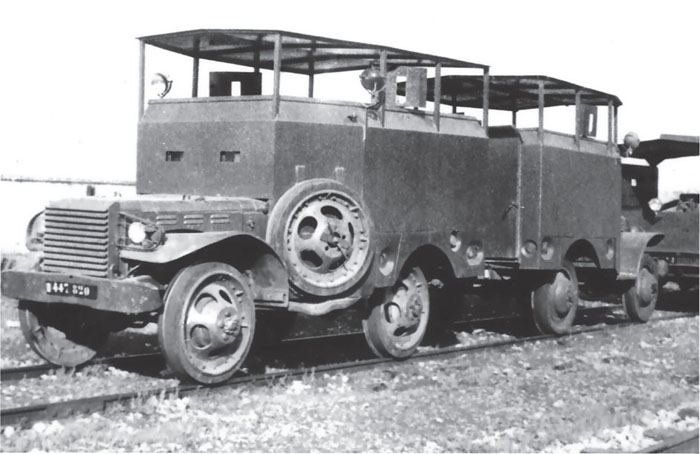
Dodge trolleys of the Oran Army Corps, here seen coupled in pairs back-to-back to allow for travel in both directions without using a turntable, followed by a Scout Car.
(Photo: All Rights Reserved)
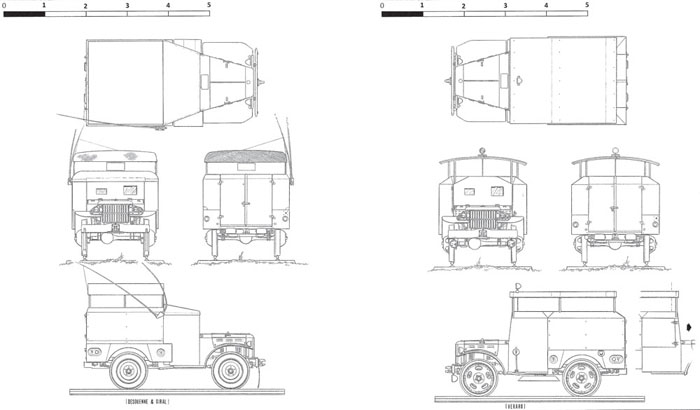
Eleven Jeeps were converted for the metric gauge between May and November 1959, and they were sent to the zone to the south of Oran to form a surveillance screen against terrorist incursions. Although far from perfect, all the converted vehicles continued in service right up until the end, as there were never enough Billard trolleys to meet all operational requirements.
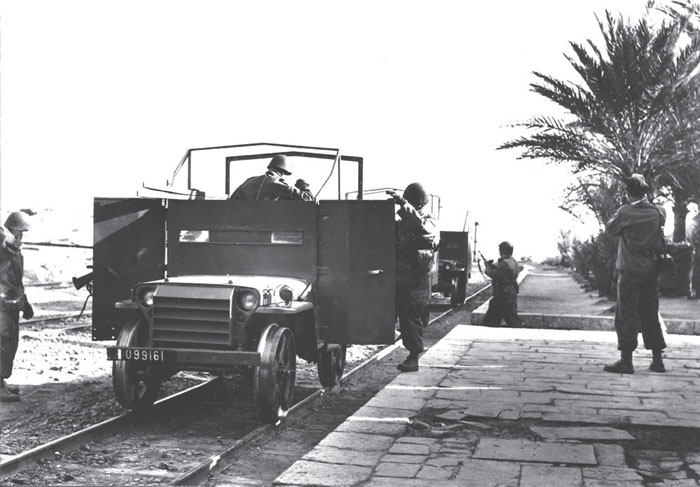
Armoured Jeep trolley of the 2nd Company, 3rd Zouaves Regiment. Conversion for the standard gauge was not practicable, as it would have entailed fitting extensions to the brake drums which would have weakened the axles. Note the much larger diameter rail wheels compared with the Jeeps used in Indochina.
(Photo: ECPA)
In addition to the machines of the C.F.A. mentioned earlier, the first additional trolleys were the metric gauge Type D 50 D 5 V36 machines repatriated from Indochina, which were received in poor condition.
Six basic types of Billard Trolleys were used:
– D 50 D 5 V (initially for Indochina, then Algeria).
– D 50 D 5 (Algerian version).
– D 50 D 4 B (built as an armoured version only, for the standard and metric gauges).
– D 50 D 4 (armour protection added).
– D 50 D 6 B (armour protection added).
The complete vehicle park of twenty units was shared out between the C.F.A. and the Army.
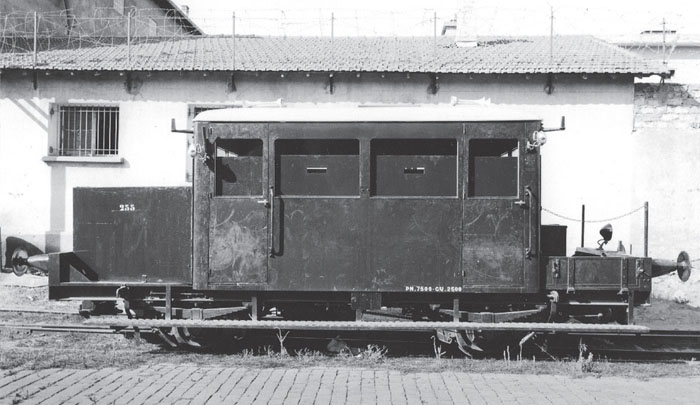
Armoured Billard Type D 50 D 5 trolley (standard gauge).
(Photo: Paul Malmassari Collection)

Front view, which shows that the armour protection was quite simple and followed the form of the original civilian bodywork. This is a Type D 50 D 5 trolley of the 587th Transportation Battalion.
(Photo: Paul Schneider)
The trolleys continued to evolve during the course of the conflict, but it is difficult to know whether this evolution resulted from the requirements of the Army High Command or from the availability of civilian chassis at the Billard factory. The final armoured versions were the Type D 50 D 6 B, built for both the standard and metric gauges, and which profited from the experience gained with the Type D 50 D 4. In the final models the 7mm armour plates were simply fastened to the body in such a way that the trolleys could easily be converted to civilian configuration.
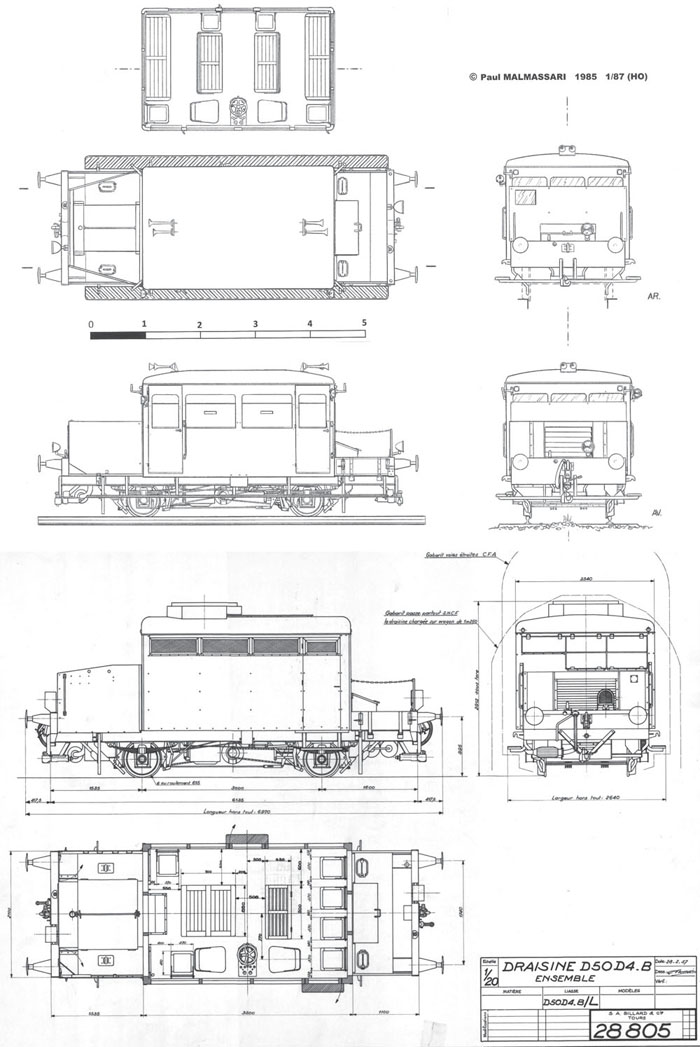
A builders’ drawing of the D 50 D4 B for the standard gauge.
(Drawing: Paul Malmassari Collection)
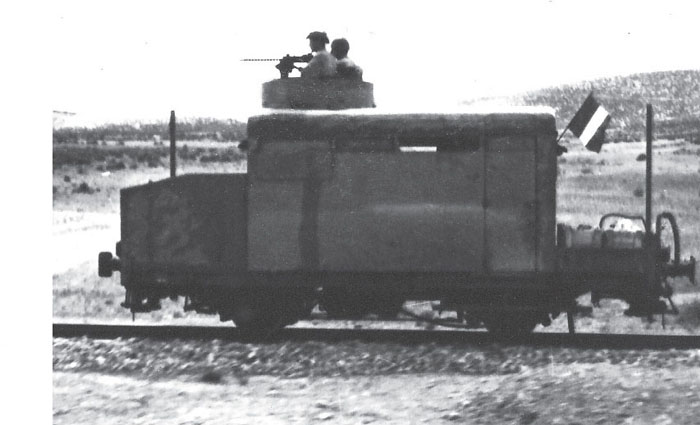
Armoured Billard Type D 50 D 4 B trolley (metric gauge). The roof cupola armed with a .30 Cal (7.62mm) Browning machine gun is typical. The Type D 50 D 4 B Trolleys were designed as armoured versions from the outset.37
(Photo: Alain Laffargue)
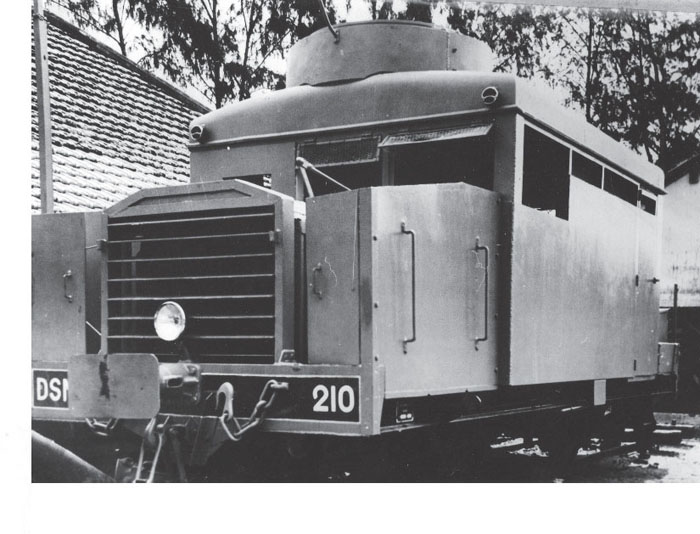
Armoured Billard Type D 50 D 4 B trolley for the metric gauge.
(Photo: Paul Malmassari Collection)
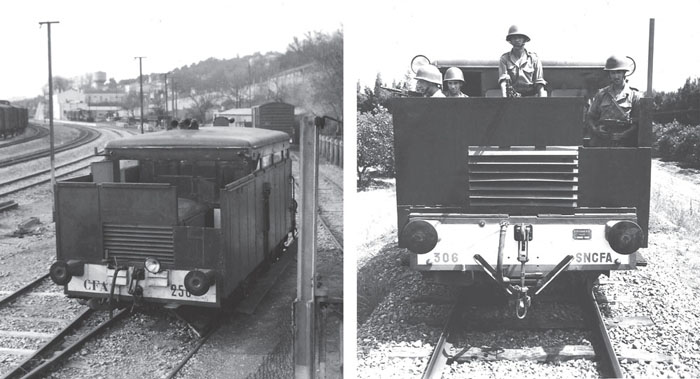
This Type D 50 D 6 B had a buffer beam which differed slightly from older models such as the trolley seen in the previous photo.
(Photos: Paul Malmassari Collection)
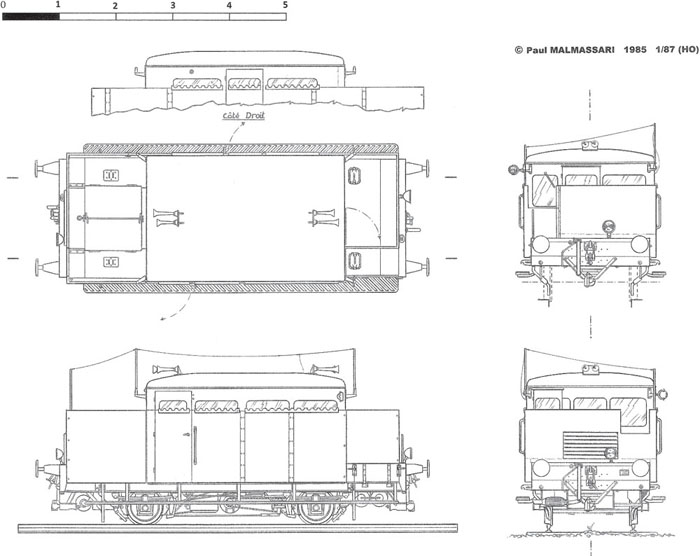
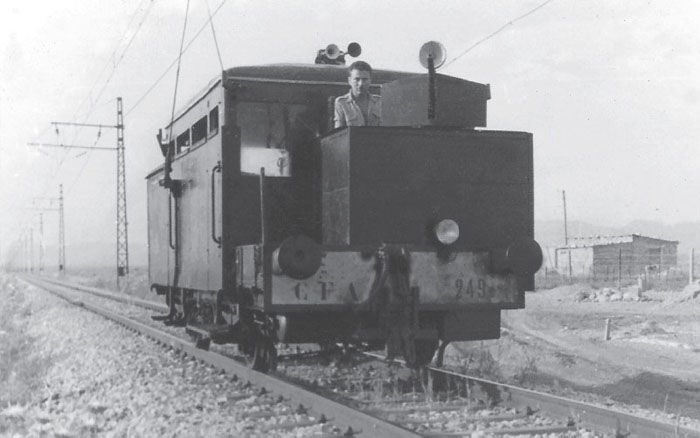
Armoured Billard Type D 50 D 6 B, seen from the rear. The windows are in 6mm plexiglass and the floor is formed from long bags filled with sand to provide a minimum of protection against mines. Note the searchlight attached to the machine gun.
(Photo: Paul Malmassari Collection)
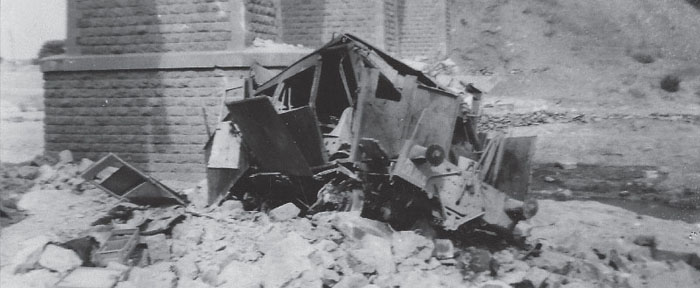
This trolley was the victim of an attack on the Oued Tebarit bridge, and has fallen 20m (65ft).
(Photo: Tallabardon, 3rd Zouaves)
In a letter dated 12 April 1958, the Director General of the Algerian Railways admitted to being ‘shocked by the degree of damage caused to the sweeper vehicles when they run over a live mine’, and he expressed a wish that studies be undertaken into the production of a vehicle rolling with no-one on board, in other words a remote-controlled machine. In actual fact, the previous year the Billard Company had drawn up such a design to comply with an SNCF study of the use of shunters in marshalling yards. Two basic considerations for military use were, firstly to minimise the vehicle’s profile so as to not overly obscure the view of the track when its controlling trolley followed close behind, and secondly to provide armour protection for all vulnerable parts so the controlling trolley could fire on the whole forward zone, which could involve rounds striking the radio-controlled trolley.38 It was planned to carry ten tonnes of ballast (worn-out rails) over each axle to ensure the detonation of mines. After several trials, ten trolleys were ordered, and the first was delivered on 10 April 1959. However, the results were far from satisfactory, and it appears that only two of these trolleys were used successfully.
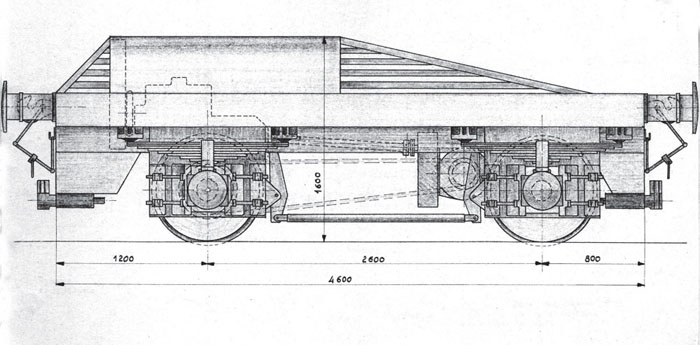
The initial design proposed by Billard. The superstructure would be modified, but the overall dimensions of the chassis would be retained in the production version.
(Builder’s drawing: Paul Malmassari Collection)
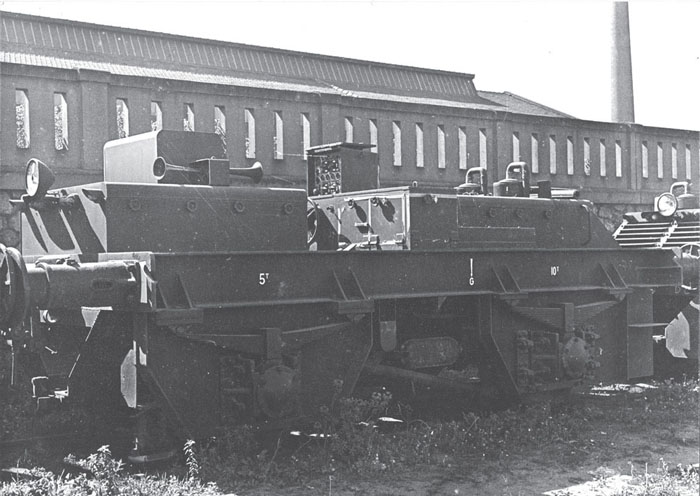
Billard Radio-controlled trolley (initial configuration). The armoured flap of the receiver unit has been left open.
(Photo: ECPA-D)
In the course of the entire war in Algeria, between 190 and 201 armoured trolleys of various types had been employed, which was the greatest number of such vehicles of all the countries engaged in anti-guerrilla struggles.
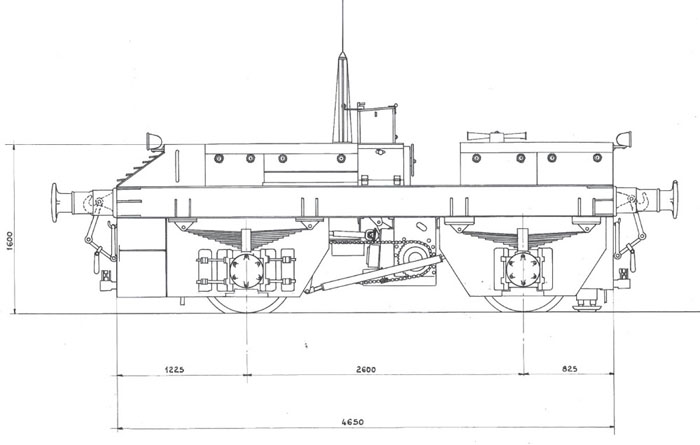
The production vehicle as delivered to the French army. The plan view is missing from the archives.
(Builder’s drawing: Paul Malmassari Collection)
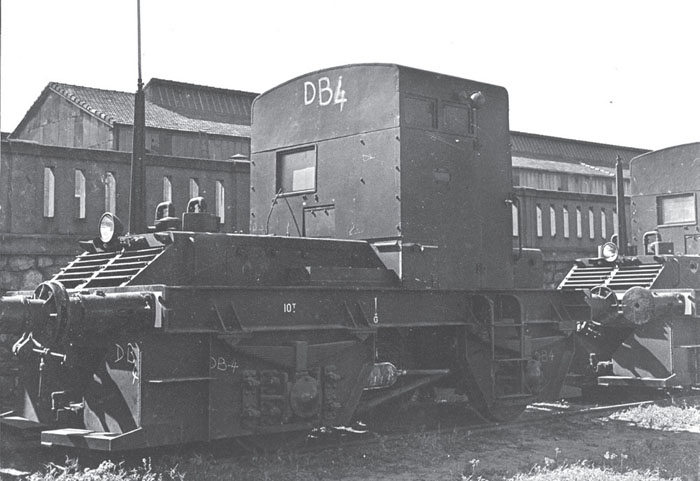
Billard Radio-controlled trolley equipped with an armoured cab. The obvious drawback of this configuration was that the cab obscured the view of the track from the following trolley or train.
(Photo: ECPA-D)
The first armoured train was built in Algeria in October 1956. Traction was provided by a 400hp shunter, enabling it to run at 35–40km/h (22–25mph). In 1957 the Army Engineers in Algeria began construction of an armoured train (ultimately nicknamed ‘Tortue’ or ‘Tortoise’) for the 587th Transportation Battalion. The four drawings below by the author show elements of the ‘Tortoise’. In total six or seven armoured trains would be built.
Algeria would be the last theatre of war in which France used armoured trains and trolleys of indigenous design. But other countries or regions in conflict have profited from the French experience: Mauritania, Portugal, the Bosno-Croat Federation etc, which we describe in the relevant chapters.
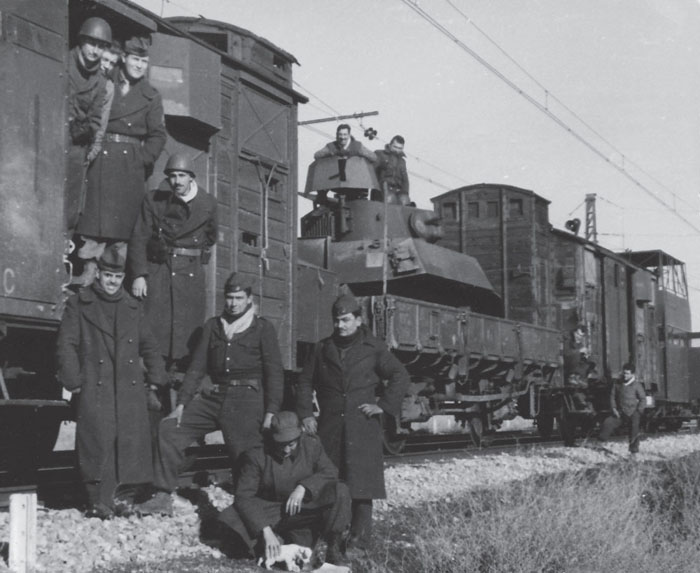
Command van during a mission to escort a goods train (1st Company, 3rd Zouaves Regiment). The vehicle on the far right could be a Billard trolley, but the structure on its roof remains a mystery.
(Photo: Tallabardon)
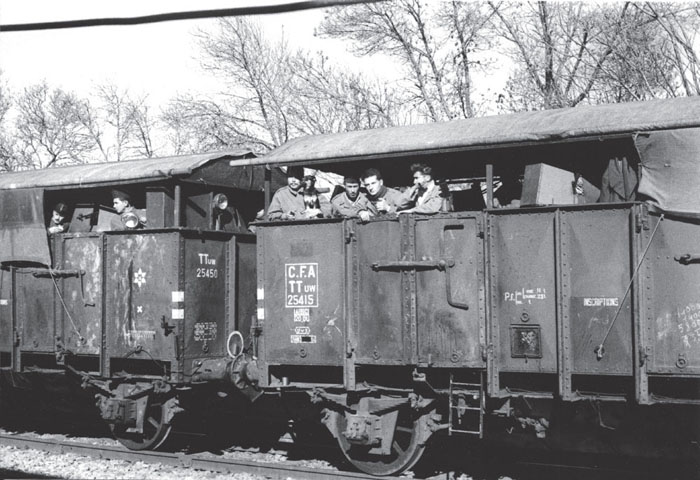
Two infantry firepower wagons of an armoured train of the 587th Transportation Battalion, in an atypical configuration.
(Photo: Dominique Loiseau)
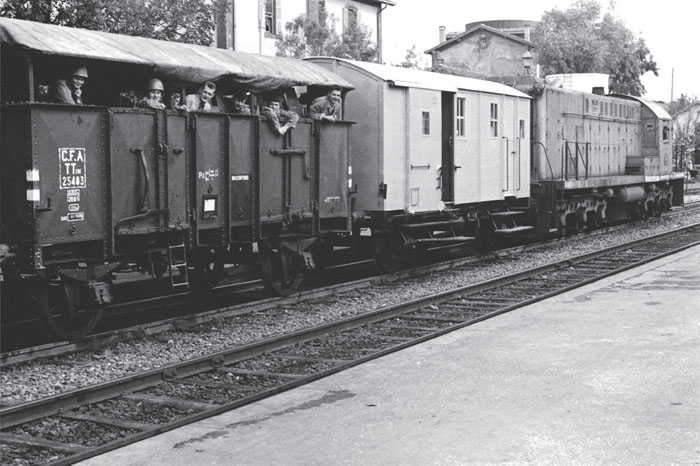
Here the armoured train has been split up and wagon TTuw 25483 has been included as the escort of a goods train. Note that the cab of diesel-electric locomotive 040-DC-13 has been armoured.
(Photo: Dominique Loiseau)
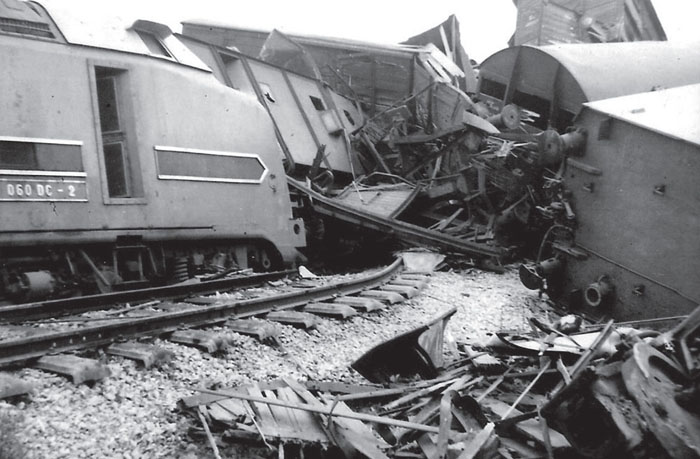
An escort van crushed between its train and the locomotive.
(Photo: Guy Chabot, 3rd Zouaves Association)
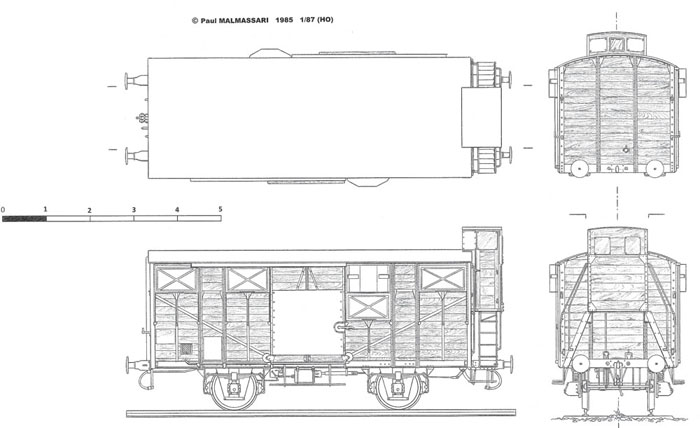
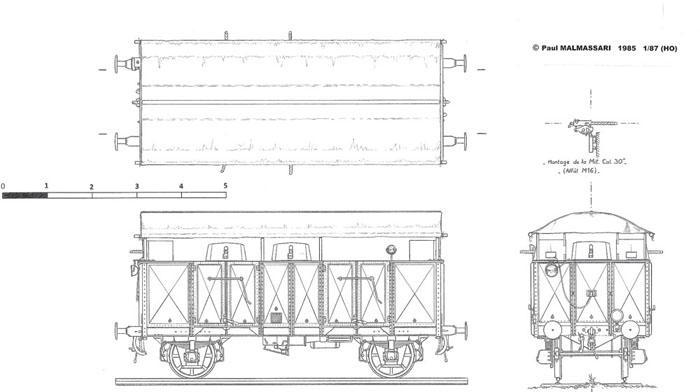
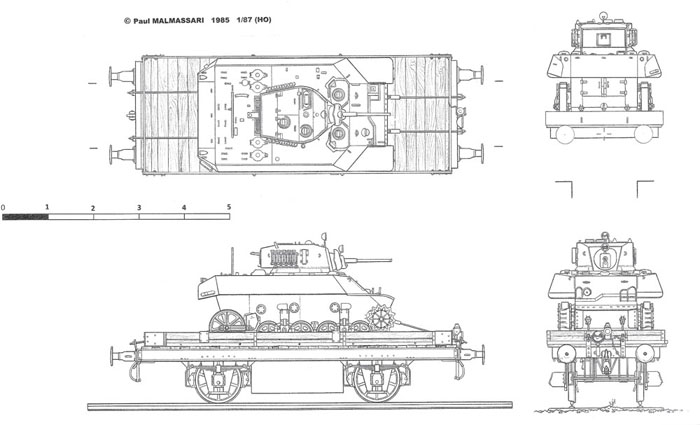
M3A3 Stuart light tank mounted on a two-plank wagon. A photo of this combination in use in Algeria appears in the Introduction.
(Drawing: The Author)
Archives:
Guy François.
Paul Malmassari.
Cercle généalogiste de la SNCF (album Emile Moret et Eugène Hallard)
Carton SHD 16 N 755.
Books:
Chabot, Guy, Le Plus sale boulot – Guerre d’Algérie 1956-1962 (Coulommiers: Dualpha Editions, 2006).
François, Guy, Les canons de la victoire, tome 2 : L’Artillerie lourde à grande puissance (Paris: Histoire et collections, 2008).
Histoire militaire de l’Indochine française des débuts à nos jours (juillet 1930) (Hanoi-Haiphong, 1931), Vol 2, p 292.
Jeudy, Jean-Gabriel, and Tararine, Marc, La Jeep, un défi au temps (Paris: Editions Presse Audiovisuel (E.P.A.), 1981).
Malmassari, Paul, Les Trains blindés français 1826-1962, étude technique et tactique compare (Saint-Cloud: éditions SOTECA, 2010).
Conferences:
Malmassari, Lieutenant-Colonel Paul, ‘La Défense dynamique des voies ferrées contre le terrorisme: l’exemple français’, actes du symposium Armée et technologie, Pully (Switzerland) 16 to 20 March 2004, pp 535–54.
Films:
http://www.britishpathe.com/video/french-gun-battery-onrailway/query/armoured+train
‘Les trains vus par le cinéma des armées’, ECPA-D, 2012, 61 min. Kowal, Georges, ‘Avec la Rafale’, 1952, ref. SCA No 0050.
Journal articles:
Aiby, Lieutenant André, ‘L’emploi des trains blindés’, La Revue d’Infanterie Vol 83 (November 1933), pp 775–95.
Dufour, Pierre, ‘1948 Rafale contre Viet-Minh’, Hommes de guerre (January 1989), pp 27–32.
Dupont, Michel C, ‘Trains blindés sur voie métrique en Indochine’, Le Rail No 7/8 (December 1988), pp 72–5.
François, General Guy, ‘Les Trains blindés français de 1914’, Ligne de Front No 54 (March-April 2015), pp 20–9.
Le Bris, Pierre, ‘Les Chemins de fer du Viet-Nam de 1945 à 1954’, VAUBAN, bulletin de liaison du genie No 96 (3rd Quarter 1990), pp 6–11.
M., Captain, ‘Les Trains blindés’, La France militaire No 11795 (23rd May 1924), p 1.
Medard, Frédéric, ‘Le soutien de l’armée française pendant la guerre d’Algérie’, Revue Historique des armées No 4 (2002), pp 25–36.
Montgéry, M. de, ‘Observations de M. Paixhans, avec les répliques de M. de Montgéry, au sujet de deux ouvrages intitulés: Nouvelle Force Maritime’, Bulletin des sciences militaires Vol 3 (1826), pp 218—19.
Neviaski, Captain Alexis, ‘L’audace du rail: les trains blindés du Sud-Annam’, Revue Historique des armées No 234 (2004), pp 25–36.
Novels:
Meney, Patrick, La Rafale (Paris: Denoël, 1990).
Tauriac, Michel, La Vallée des Dieux (Paris: Flammarion, 1989).
Website:
http://www.forum-auto.com/automobiles-mythiques-exception/voitures-anciennes/sujet388213.htm


Two photos showing the opposite ends of armoured train ‘Tortoise’ of the 587th Transportation Battalion. Although the wagons are of the same type, there are slight differences in the markings and also the position of the electric lamp sockets.
(Photos: Dominique Loiseau)
1. In addition there were the projects of Baron Rystany (1864), M. Bukaly (1867), and M. Evrard (1868).
2. For further details of this project, see the chapter on Great Britain.
3. Michel Body, Les Chemins de Fer dans leurs applications militaries (Paris: Eugène Lacroix, 1868), pp 21–2.
4. Meudon was the workshop created by Napoleon III in 1860 to carry out secret research projects.
6. Previously, in 1877 Mougin had proposed 155mm guns on disappearing mountings on rail platforms.
7. Also described in ‘Panzerzug’, Polytechnische Schau, 1916, Band 331, Heft 19, p 299.
8. To complete the story of the overseas armoured trains, we must mention the armoured wagons built in Abyssinia in 1916, of which we have unfortunately found no photos.
9. TAZ = Tous AZimuts (all-round fire).
10. ALGP = Artillery Lourde à Grande Puissance (High-Powered Heavy Artillery).
11. ALVF = Artillerie Lourde sur Voie Ferrée (Heavy Railway Artillery).
12. Train ‘F’ at Damascus (Baranké Station), Train ‘G’ at Rayack, plus Train ‘C’.
13. Concerning projects, in October 1924 a certain M. Mescherinoff proposed an armoured road-rail tractor unit. As it lacked workable technical details, the Army High Command did not follow up his proposal (SHD W 872).
14. Report No 6, meeting of 1 December 1931, dealing with firing trials with a machine gun on an armoured trolley (C.A.A. file not found).
15. Noguès commanded the XXIX Army Corps in Algeria in 1933 then from 1936 to 1940, he was resident general in Morocco.
16. Service Note No 464/MC, of 3 July 1940, 3 H 1264/5 (SHD).
17. In October 1942 the British intelligence service at the post of Bathurst in the Gambia reported the presence of an armoured train, armed with twelve machine guns, on the Dakar-Thiès line.
18. During the Liberation fighting, in order to attack the German garrison at Ussel, plans were made to armour the ‘Tacot’ (the name for the Transcorrézian train), but this was never carried out.
19. Three landing beaches were designated by the colours Blue (South), Red (North) and Green (Centre).
20. Order of battle of the French troops in Indochina, 23 November 1943; Order of battle of the troops of the Indochina Group, May 1944 (10 h 80/D1, SHD).
21. Paul Malmassari, Les Trains Blindés 1826–1989 (Bayeux: Editions Heimdal, 1989), p 199.
22. From Jean-Gabriel Jeudy and Marc Tararine, La Jeep, un défi au temps (Paris: Editions Presse Audiovisuel (E.P.A.), 1981), p 182.
23. ‘V’ for ‘Vietnam’. Three were delivered on 7 February 1953 (Nos 89, 90, 91), and the following three on 18 April 1953 (Nos 94, 95, 96). Notes taken by the Author at the SOCOFER Works in 1983.
24. A personal perspective has come down to us in the novel La Vallée des Dieux by Michel Tauriac. He travelled several times on ‘Rafales’, and his eye-witness testimony worked into the narrative of his novel brings to life the dry facts reported in the Archives.
25. These Type MM or D bogie flat wagons were also called ‘control platforms’, ‘shock wagons’ or ‘protection chassis’.
26. Range of the Bofors at high elevation was 9830m (10,750 yards) but British ammunition normally self-destructed at 3200m (3500 yards); max AP range of the Ordnance 2pdr (40mm) QF in the Coventry turret was 1370m (1500 yards) but no HE shell was ever mass produced, the turret relying on its coaxial 7.92mm Besa MG.
27. The Type HH wagons, wood or steel high-sided bogie wagons 10.1m (33ft 1½in) long, were principally used for wagons with a central armoured casemate such as for armoured cars, mortars or command posts.
28. The high-sided wagons Type H, 5.5m (18ft) long were specially used as gun wagons with turrets from armoured vehicles, and are not to be confused with the letter ‘H’ of the tank which corresponded to ‘Hotchkiss’.
29. TCE = Chemin de fer Tananarive-Côte Est; MLA = Chemin de fer Moramanga -Lac Alastre.
30. In December 1956 it was noted that ‘… the rebels are beginning to attack rail traffic’ (Note from the military transport HQ in French North Africa to the Colonel who was Transport Director of the 10th Military Region, 1 H 2177/D1, SHD)
31. 2227km (1384 miles) as against 2113km (1313 miles) of standard-gauge track.
32. Letter from the Director of the C.F.A. to the Governor General of Algeria, No IA8/67-15 dated 17 November 1955 (1 H 2177, sleeve ‘Notes CGA 1955-1956’, SHD).
33. Their armament consisted of a semi-automatic pistol, an LMG, five rifles and a rifle-grenade launcher.
34. The special pneumatic tyres on flanged wheels were produced by Michelin (as used on their Micheline railcars).
35. VEhicule RAil-ROute (Road-rail vehicles), the former Sibille company.
36. ‘V’ for ‘Vietnam’.
37. One of these trolleys is still in existence at the time of writing.
38. This scenario was far from uncommon in anti-guerrilla actions: in Indochina, tanks and even armoured railway wagons had been obliged to fire on their fellow units to sweep them clear of attackers who had scrambled on top of them.